
CIOB PRESIDENT MIKE KAGIOGLOU EXPLAINS THE UN SUSTAINABLE DEVELOPMENT GOALS
CONSTRUCTION
ENVELOPE COMPETENCY | GREEN ROOFS AND FIRE SAFETY | HERITAGE IN CORNWALL constructionmanagement.co.uk JULY/AUGUST 2024
MANAGEMENT
GLOBAL PERSPECTIVE


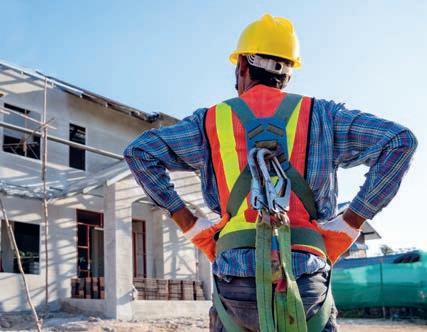


CONSTRUCTION MANAGEMENT JULY/AUGUST 2024 | 3 Contents n constructionmanagement.co.uk 07/24 Contents News 04 News in pictures 06 News: CIOB’s new AI Playbook 07 News: Kagioglou plans task group 08 News: CIOB election manifesto 10 News: SME diversity guidance 12 Data: Tender price insights Opinion 14 Feedback: Readers’ views 16 Caroline Gumble on inclusivity Interview 18 CIOB president Mike Kagioglou Targeting UN sustainability goals Technical 22 Approved Codes for new homes Trading Standards protection Roofing & Cladding 24 Building envelope competence Proving competency in the sector 28 Penzance Market House Restoring a historic lead roof Partnership 32 CSCS renewal deadline passes New routes to accreditation Global 34 Legal changes in Saudi Arabia Implications for contracts CPD 36 Green roof fire safety guidance Complying with the regulations 40 Patent and latent defects How they differ and what they mean Legal 44 Contract Clinic: Adverse weather Careers & Recruitment 46 Language difficulties on site Research into communication Community 48 Carbon benefits of cob research 49 CIOB CEO visits Hinkley Point C 50 TL links industry and academia 51 Award for Building Equality group 54 Walter Lilly celebrates centenary 55 Morgan Sindall helps the homeless 56 Preserving heritage with Velux Diary dates 58 Highlights of the CIOB calendar 46 28 24 36

UK’s largest monopiles transported to Moray West
Lifting specialist Sarens PSG has installed 62 giant monopiles, each weighing up to 2,000 tonnes, with diameters reaching up to 10m and extending to 84.7m in length, at the Moray West offshore wind farm in Scotland. The heavy lifting specialist used a self-propelled modular transporter of 166 axle-lines.

Tunnelling robot prototype
A consortium including Costain and the Manufacturing Technology Centre has developed a prototype robot to make tunnel infrastructure installation more efficient and safer. The robot can autonomously select brackets, locate where they need to be mounted along a tunnel wall and install them.
4 | CONSTRUCTION MANAGEMENT JULY/AUGUST 2024 n News constructionmanagement.co.uk ANDREI ZOTA/COSTAIN
Dr Morwenna Fellows talks about how her research uncovered the communication issues that arise on site where there is no shared first language (p46-7)


Barhale for Mogden shaft
Thames Water has appointed Barhale to deliver the Mogden Pump Out Shaft scheme, which will upgrade the existing inspection shaft on west London’s Thames Water Ring Main. Barhale will install four 350kW VSD pumps, each capable of delivering a peak flow of 36Ml/d (417l/s), to give a combined 108Ml/d (1250l/s) from any three of the pumps.
Tyne Bridge restoration
An Esh Construction operative undertakes a cleanup operation under the footway of the Tyne Bridge. The bridge hangars of the famous structure in Newcastle upon Tyne are undergoing essential repairs.
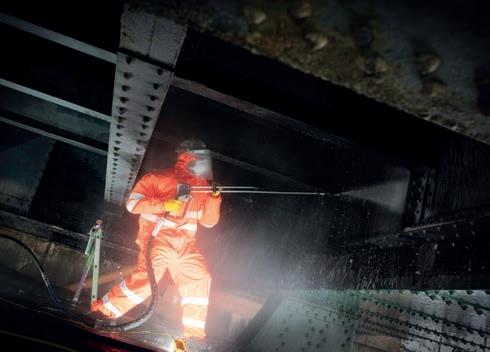


Future Homes Standard pilot
Latimer, the development arm of Clarion Housing Group, has completed a project in Cottered, Hertfordshire, designed to meet the Future Homes Standard. Seven new homes showcase two approaches to meeting the standard: a fabricfirst approach in the terraced houses and a technology-led approach in the bungalows.
2024 Serpentine Pavilion
Aecom has been the technical adviser for the Serpentine Pavilion in London’s Kensington Gardens for the 12th consecutive year. Designed by Korean architect Minsuk Cho and his firm Mass Studies, Archipelagic Void has been built using sustainably sourced Douglas fir timber as the main material.
CONSTRUCTION MANAGEMENT JULY/AUGUST 2024 | 5 News n constructionmanagement.co.uk
ANDREW HEPTINSTALL PHOTOGRAPHY

CIOB launches playbook for AI in construction
The new guidance will help SMEs get to grips with artificial intelligence, writes Justin Stanton
CIOB has launched a playbook that aims to support construction companies of all sizes in the use of artificial intelligence (AI), in particular SMEs.
The AI Playbook was written by CIOB’s Digital and Innovation Advisory Panel for built environment organisations of all sizes seeking to get to grips with AI technology and understand how to get the best from it. It includes ways to evaluate its effectiveness, while also considering matters such as ethics, cyber security and data protection.
There is also a checklist to support new entrants, early adopters and experienced AI practitioners in making decisions about their use of the technology.
The playbook references how AI has the potential to revolutionise working processes for SMEs, by enabling them to compete at a larger scale. It says that, through use of AI, SMEs can tap into capabilities that were once only available to large construction organisations, meaning they can compete on a more level playing field.
It also addresses industry concerns and misunderstandings about AI’s impact on the jobs market. The playbook says AI in construction can enhance human capabilities rather than replace them as its use requires a certain level of user skill and understanding, meaning many existing roles will evolve – transitioning from
The construction industry is in the age of AI, whether we recognise it or not
David Philp, CIOB
operators to supervisors, where professionals will increasingly find themselves checking and validating AI systems’ work.
A report released by the House of Lords in February 2024 revealed construction and extraction roles are least likely to be threatened by AI. Other job roles on the same list included building and grounds cleaning/maintenance, and installation, maintenance and repair jobs.
David Philp, chair of CIOB’s Digital and Innovation Advisory Panel, and one of the playbook’s authors, said: “Forms of AI are now prevalent in all walks of life and business, and the construction industry is in the age of AI, whether we recognise it or not. Understanding AI in the context of our sector is vitally important to help determine and shape how it might usher in new opportunities.
“AI can immensely support project and construction management, analysing large volumes of project data across the value chain, spotting potential safety risks through computer vision, and offering insights for smarter decision-making.
“It can also support the automation of repetitive tasks, such as everyday data entry, form filling and report generation, all of which can dominate a construction manager’s day, so it’s there to be embraced.” ● Download the AI Playbook for free at https://ciob.me/AIPlaybook.
6 | CONSTRUCTION MANAGEMENT JULY/AUGUST 2024 n News constructionmanagement.co.uk
CIOB president wants construction to follow UN Sustainable Development Goals
Professor Mike Kagioglou is planning a ‘task group’ to help the built environment understand the United Nations framework. By Will Mann

New CIOB president Professor Mike Kagioglou starts his term in office with a call for construction to measure its impact against the United Nations Sustainable Development Goals (SDGs).
“The SDGs provide a framework that can help the industry become more innovative and sustainable – they are relevant to all the major
Mike Kagioglou: ‘I’m keen for any construction companies interested in the SDGs to contact me’
issues construction is facing,” said Kagioglou, who is pro-vice chancellor for research and business innovation at De Montfort University (DMU).
The 17 SDGs were created through the 2030 Agenda for Sustainable Development which was adopted by all United Nations members in 2015. They highlight the connections between the environmental, social and economic aspects of sustainable development.
“I think the big construction companies, who already do great work in areas like social value and environmental sustainability, would be interested in mapping their organisations against the SDGs to see what their performance is,” Kagioglou said.
“I would like to get a group of champions together from the industry, representatives from 10 or 20 companies initially, and create a task group for construction. It would allow them to showcase the excellent work they’re doing, gain a competitive advantage with clients, plus these examples can help others learn and drive the whole sector forward. So, I’m keen for any construction companies interested in the SDGs to get in touch with me.”
The higher education sector provides a model that Kagioglou believes construction could follow.
“The Times Higher Education Impact Rankings are global performance tables that assess
I think the big companies, who already do great work in areas like social value and environmental sustainability, would be interested in mapping their organisations against the SDGs to see what their performance is Mike Kagioglou, CIOB
universities’ performance against the SDGs,” he says. “Institutions submit evidence each year about their progress, and they are ranked in the table. Importantly, universities are measured on their activities and output – how they impact the environment and society as a whole.
“Construction has an impact on everyone around the globe – all eight billion of them! – the people we employ, those in supply chains, the end users of buildings we construct. So wouldn’t it be sensible to find a way of measuring and reporting that?”
Kagioglou says all the UN SDGs have relevance to construction but particularly:
l Goal 9: build resilient infrastructure, promote inclusive and sustainable industrialisation and foster innovation; and
l Goal 11: make cities and human settlements inclusive, safe, resilient and sustainable; and
l Goals 13, 14, and 15, which are about climate change, conservation and biodiversity. l
CONSTRUCTION MANAGEMENT JULY/AUGUST 2024 | 7 News n constructionmanagement.co.uk
WESTERN SYDNEY UNIVERSITY
CIOB sets out recommendations for next UK government
The institute launched a pre-election manifesto outlining key areas to support the built environment sector

CIOB has laid out in a manifesto ahead of the 4 July general election what it believes should be the top priorities for the future government.
CIOB’s Manifesto for the Built Environment: Opportunities for future proofing the construction industry has been developed around four major themes, including environmental sustainability, quality and safety, the future of construction, and people and skills.
The document outlines short-, medium- and long-term policy recommendations to address some of the most pressing challenges
Candidates
don’t always understand
the complexities of the sector, so it’s down to us all to educate them
Caroline Gumble, CIOB
CIOB’s manifesto recommendations
Environmental sustainabilityQuality and safety
● Develop and implement a green skills fund
● Adapt building regulations to include whole-life carbon assessments
● Develop and implement a national retrofit strategy
facing construction and society, such as the ongoing skills shortage, net zero, better opportunities for SMEs and improving diversity and inclusion.
CIOB’s chief executive, Caroline Gumble, said: “We’ve launched our manifesto so we can engage with prospective parliamentary candidates while they’re developing their own campaigns.
“Candidates come from a range of backgrounds and don’t always understand the complexities and importance of the built environment sector, which is a major economic driver, so it’s down to us all as the experts to educate them.
“It’s important they know what support is needed to enable the industry to play its part in creating a safe and sustainable built environment for everyone.
“I strongly encourage CIOB members to use this manifesto to engage with those standing for election in the constituencies they live and work in to help push construction further up the political agenda.” ● Read CIOB’s Manifesto for the Built Environment at www.ciob.org.
● Review the voluntary status of consumer codes for new-build housing
● Provide fairer opportunities for SME housebuilders
● Reform the current land value system

CIOB Awards 2025 entries open
CIOB is now accepting nominations for its prestigious awards celebrating the most talented individuals in the construction industry.
CIOB Awards categories include Rising Star, Team of the Year, Client of the Year and the coveted Construction Manager of the Year title. The institute will host the event, formerly known as the Construction Manager of the Year Awards, at the London Hilton Metropole Hotel on 15 May 2025.
The closing date for entries is 13 September 2024. CIOB will reveal the list of finalists later this year. To enter your nomination visit awards.ciob.org.
Future of constructionPeople and skills
● Tackle late payment culture
● Develop and implement a strategy for modern methods of construction
● Use geographical clustering to level up the UK
● Include equality, diversity and Inclusion (EDI) commitments in public sector contracts
● Overhaul of the Apprenticeship Levy
● Introduce a Built Environment GCSE
8 | CONSTRUCTION MANAGEMENT JULY/AUGUST 2024 n News constructionmanagement.co.uk
Built on Safety

Join Us in Building a Safer World. At Knauf, we prioritise your well-being.
Our rigorous health and safety standards meet and exceed regulatory requirements to ensure a safer environment for everyone.
Discover how we’re setting new benchmarks in safety –scan the QR code to learn more and join us in creating a safer world. Build on us.
Percentage of disabled workers in construction

New guidance for SMEs on diversity and inclusion
CIOB has published ‘step-by-step’ advice on adopting fair and equitable practices across company employment
CIOB has launched its first technical information sheet on diversity and inclusion, providing practical guidance for companies in the built environment sector. The document is aimed at smaller companies with limited time and resources.
According to the Construction Industry Training Board, an estimated 251,500 additional workers will be needed by 2028 if the sector is to meet its forecasted growth. Despite this acute labour shortage, construction has not successfully tapped into the potential of bringing more talent from underrepresented groups into the industry.
Of all construction staff in the UK, only 15% are women (with up to 2% in onsite roles), 6% are from Black, Asian or other minority ethnic groups and just 6% of the workforce define as disabled.
The guidance has been written in an easily accessible format. It can be used by employers of any size and different work environments and includes recommended actions on all aspects of the employee journey: from recruitment and development to senior leadership, communications and community engagement.
The recommendations in the technical information sheet are also supported by real-life case studies
Construction has not yet successfully tapped into the potential of talent from underrepresented groups
This document will be an excellent asset for employers keen to adopt inclusive practices for commercial advantage and to contribute to making the industry welcoming to all Mark Harrison, CIOB
from a range of companies, including CIOB corporate members.
Mark Harrison, head of equality, diversity and inclusion transformation at CIOB, said: “We are confident that this document will be an excellent asset for employers keen to adopt inclusive practices for commercial advantage and to contribute to making the industry welcoming to all.
“Producing the technical information sheet on diversity and inclusion is part of our ongoing work to ensure that the built environment sector is as diverse, accessible and inclusive as possible.
“This work derives from the CIOB’s Royal Charter, the first objective of which is to promote the science and practice of building and construction for the public benefit, so not just for our members, and that includes the people using the buildings and infrastructure that our members create.
He added: “It is an example of CIOB demonstrating leadership on an important issue facing the sector that will help contribute to addressing the people shortage and skills gaps.” ●
The Technical Information Sheet on Diversity & Inclusion is free to CIOB members, with a nominal charge of £15 to non-members. It can be downloaded at www. ciobacademy.org/publications.
10 | CONSTRUCTION MANAGEMENT JULY/AUGUST 2024 n News constructionmanagement.co.uk
6
Document, drawing and email management on Microsoft 365






Trusted by AEC firms of all sizes

Document Management

Bi-directional syncs with BIM authoring, CDEs & drawing tools Integrations

Drawing Management
Manage all information with a single source of truth






Email Management
Seamlessly retrieve crucial project information
Ensure quality control & reduce project risks A complete, secure portal for recording & exchanging project information Full Audit History

Reduce project risk with ISO 19650 and ISO 9001 automation & standardization tools Secure Document Compliance
cmap.io/atvero
Access
your project information anytime, anywhere
Learn more and book a demo here
April Team Meeting - Minutes First Floor Flooring - Plans Second Floor Specifications Project Control File Project Information Email Company Address Job Title Mobile Phone Project Role GDPR

Construction output forecasts look bright – but what about tender prices?
Although construction output data offers useful insights for tender prices, considering other indicators is crucial to get a fuller picture, says Pablo Cristi Worm

Construction tender price inflation (TPI), the rate that measures the trend of contractors’ pricing levels in accepted tenders, can be a challenging metric to both measure and predict. It can fluctuate significantly and is heavily influenced by a series of macro and microeconomic factors. However, interrogating TPI’s key data points helps bring insight into the potential for future fluctuations. Demand is one of the most decisive drivers of tender price inflation. As investment and activity increase, contractors become busier, leading to a shortage of builders and decreasing competition. With less competition, securing work becomes easier,
allowing contractors to be more selective about which projects to bid on and ultimately resulting in higher prices. Conversely, if the market price of an asset is perceived as low, then fewer firms would want to supply the product.
This situation arises because firms are in competition with each other. For example, in the London commercial property market, when the return on investment in offices is low, property prices are high, and the returns reflect the low risk of property investment. In such a market, developers may see an opportunity to develop a site and sell into the highprice office market at what appears to be an attractive profit.
The past two decades offer a clear illustration of the dynamic between construction output and tender price
inflation. Construction output has echoed economic performance, with sharp contractions during the global financial crisis in 2008 and the European sovereign debt crisis in 2012. Construction output plummeted again during the Covid-19 pandemic, and more recently has been impacted by the ongoing conflict in Ukraine and global supply chain disruption.
This decline in output has been mirrored in tender price inflation trends. The smoothed data in the top graphic on p13 reduces the volatility of the time series and shows a clear link between the two measures. In this case, the smoothed series is a moving average of the previous six months. This flattens out any sudden peaks and troughs and keeps only the volatility that is due
to persistent shocks, like Covid-19 or the conflict in Ukraine. After the sharp drop and subsequent rebound following the pandemic, construction output peaked at 3.2% in Q1 2022 but has been trending downwards ever since.
By Q4 2023, construction output had contracted by 0.9%, repeating this contraction in Q1 2024. Similarly, the All-in TPI from the Building Cost Information Service (BCIS) peaked in Q2 2022 at 4.6% quarter-on-quarter, decreasing to 0.5% in both Q4 2023 and Q1 2024.
Future outlook for demand
Despite recent declining construction output, sentiment within the sector continues to paint an optimistic picture. Indicators like the June S&P Global UK
12 | CONSTRUCTION MANAGEMENT JULY/AUGUST 2024 n Data constructionmanagement.co.uk
The commercial and retail sector is showing the most significant growth within construction, driven primarily by refurbishment
Construction PMI are positive, and workload expectations as measured by the RICS construction market survey show a doubling in Q1 2024 compared to the previous quarter.
Construction new orders, a forward-looking snapshot of potential future activity in the construction industry, offer a positive outlook as well. Q1 2024 saw a significant quarterly increase of 15.9% in the total value of new orders – the best quarterly performance since Q4 2021, just before the conflict in Ukraine began. Since TPI closely tracks fluctuations in construction output, an increase in tender prices is also likely. However, construction projects involve lengthy periods between planning and actual work commencement. As such, new orders don’t automatically translate to immediate activity.
Barbour ABI’s contracts award data offers insight into projects that are closer to starting work on site. This also presents a bright picture, with awards for Q1 2024 showing a robust increase of 35% compared to Q4 2023. The commercial and retail sector is showing the most significant growth within construction, driven primarily by refurbishment projects. However, this is starting from a lower initial base, as the office fit-out sector, for example, is reawakening from a period of dormancy.
Pablo Cristi Worm is an associate economist at Turner & Townsend.
Percentage increase in the total value of new construction orders in Q1 2024
Construction output v tender price index
The smoothed growth rate reduces the volatility of the historic events and shows a clear link between the two measures

Contracts award by sector
Quarter-on-quarter percentage change between Q4 2023 and Q1 2024
CONSTRUCTION MANAGEMENT JULY/AUGUST 2024 | 13 Data n constructionmanagement.co.uk 15.9
-30 -10103050 70 90110130
ABI 2004 Q1 2006 Q3 2009 Q1 2011 Q3 2014 Q1 2016 Q3 2019 Q1 2021 Q3 2024 Q1 10 8 6 4 2 0 -2 -4 -6 -8 -10 Commercial & retail Medical & healthcare Infrastructure Residential All sectors Education Industrial Hotel, leisure & sport % SOURCE: BUILDING COST INFORMATION SERVICE AND OFFICE FOR NATIONAL STATISTICS n Global financial crisis n European debt crisis n Covid-19 n Ukraine Construction output Building Cost Information Service All-in tender price inflation %
SOURCE: BARBOUR
Feedback
A selection of readers’ comments about news and issues in the industry from across the CIOB community and social media

CIOB People
Ending the scourge of damp in buildings
Building pathology specialist Professor Michael Parrett FCIOB told CIOB People how “antediluvian approaches” are preventing industry professionals from eradicating damp and mould in housing.
Sarah Garry, chief executive, Property Care Association via LinkedIn
We agree that there needs to be a better understanding in the wider construction industry of damp and mould.
Our members are recognised as the experts in the sector, who meet the criteria set out in the government report Understanding and addressing the health risks of damp and mould in the home
Best practice, enforcement and education are vital in providing healthy living environments protected against excess moisture, damp and mould.
In response to the consultation for the Future Homes Standard, we put forward the case for comprehensive training for ventilation installers; mandatory post-occupancy testing and sign-off; and the introduction of an education programme for building occupants, to give them the knowledge to maintain and use building services effectively.
Our research in 2020 among our skilled and audited membership revealed that they believed less than 30% of ventilation installations complied with building regulations, yet the health, safety and wellbeing of occupants should be the highest priority at all times.
Best practice, enforcement and education are vital to protect against damp
Podcast
Should we just stop building?
On World Environment Day, Hero Bennett, Will Arnold and Saul Humphrey FCIOB joined a 21st Century Construction podcast debate on the industry’s role in driving down carbon emissions.
Nicholas Waring
Absolutely. ‘Do not demolish’, ie, preserve. This is the first presumption of good conservation practice. Recycle, reuse, retrofit. Fundamentally, assess what changes are for and question the feasibility of growth.
Brogan MacDonald via LinkedIn
The global nuances of this discussion are so important but it’s extremely challenging to get clients to see this bigger picture when they are tunnel-visioning on the UK and their companies’ ESG. I’m trying to get my head around how to communicate this effectively! I love Kate Raworth’s work but so many clients just don’t get nor care for the doughnut.
CM
The role of water-source heat pumps in heat networks
Recycle, reuse, retrofit. Fundamentally, assess what changes are for and question the feasibility of growth
Nicholas Waring
Tolu Fatogbe via LinkedIn
As the drive towards decarbonisation picks up, the role of ground and/or source heat pumps within heat networks cannot be overemphasised. There are still hurdles though, one of the main ones being the ‘spark gap/spread’, ie, the difference between gas and electricity prices. Retrofitting heat pumps increases the electrical loads of a network and often requires electrical upgrades. The economics can’t be ignored but can be addressed.
Share your views on the latest industry issues by posting comments online at www.constructionmanagement.co.uk or by emailing the editor at construction-management@ atompublishing.co.uk
14 | CONSTRUCTION MANAGEMENT JULY/AUGUST 2024 n Opinion constructionmanagement.co.uk
DON’T BE BY 100MM CAVITIES CONSTRAINED
Building with 150mm wall cavities allows you the freedom to choose the best insulation for your project.
And when energy requirements tighten in 2025, you’ll already be ahead of the curve.
Don’t be constrained by 100mm cavities. Stay flexible with 150mm DriTherm® Cavity Slab 32.
knaufinsulatio n .co.uk / housebuilders-hu b
 Caroline Gumble CIOB
Caroline Gumble CIOB
Let’s make construction welcoming to young professionals
If the industry wants to close the skills gap, it must first break down the barriers preventing it from becoming more inclusive, writes Caroline Gumble
I recently attended a CIOB CPD event organised by our London Hub committee on misconceptions of the skills gap – an important issue across the industry. It was a terrific evening with great panellists and an expert chair in Christine Gausden FCIOB.
We had excellent engagement from our audience, some of whom shared the challenges they faced in finding a role. I was struck by the awful irony of hosting an event about the skills gap while surrounded by some people who are struggling to find their first full-time post in the sector.
Although we often talk about getting more people into the industry, we have young construction professionals who are eager to commit to their careers and yet struggle to find jobs. They are highly educated and motivated and, as CIOB members and Tomorrow’s Leaders representatives, have made a commitment to continuous learning and to maintaining high standards in our industry.
It made me reflect on some of the asks in our diversity and inclusion charter. One of the drivers behind its publication was to help close
Although we often talk about getting more people into the industry, we have young construction professionals who are eager to commit to their careers and yet struggle to find jobs

the skills gap by tackling barriers to increasing inclusion in the industry, so I feel there’s value in looking again at some of the key questions:
● Have you scrutinised your recruitment processes, including who is doing the recruitment?
● How is the culture you are creating? Does everyone feel welcome in your offices and on your sites?
How do you engage with those looking to start a career in construction? Are there placements and opportunities to gain experience? Some applicants may lack experience but if they also lack access to opportunities, that’s something for the industry to address.
Having also talked to some of CIOB’s academic members about this,
another aspect to consider is what built environment students and young professionals can do to prepare themselves for the workplace.
I encourage all those studying built environment courses or about to start in their first role to build their professional network as early as they can. For example, by finding opportunities to visit sites, engaging in networking at CPD events, using social media for professional exposure, or considering joining our Tomorrow’s Leaders community.
If one of your goals is to be a construction professional, then take every opportunity to engage with the professionals already in the industry. ●
Caroline Gumble is CEO of CIOB.
16 | CONSTRUCTION MANAGEMENT JULY/AUGUST 2024 n Opinion constructionmanagement.co.uk
From left: Caroline Gumble, Christine Gausden FCIOB and panellists Kashyap Shah, Sally Hill MCIOB and Karina Stamburska



CONSTRUCTION MANAGEMENT
l Sustainable roofing
l How to manage ethical employment practices
l Improving design and building efficiencies
l Managing highways surface water
l Avoiding common roof defects
l Managing occupational health risks in archaeology
l Automated, mastless machine control
l Roof glazing – more than glass
l How to deliver cleaner power to construction sites
l Mechanical ventilation’s role in improving indoor air quality
l Solar PV in pitched roofing applications
l Managing biodiversity on construction sites
l Head protection in construction
l Timber and the circular economy
l Drainage pumps – construction, climate change and consultancy
Essential information for construction professionals constructionmanagement.co.uk Join 58,000 other construction professionals who subscribe to our newsletters by signing up here: constructionmanagement.co.uk/newsletter Keep up to speed with daily news, opinion, CPDs and technical info on CM’s website. Our content includes: l Breaking news l Technical articles for construction professionals l CPDs l BIM and digital construction coverage l Opinion from industry thought leaders l Legal analysis l Careers features CONSTRUCTION MANAGEMENT CM ad filler.website.indd 52 14/02/2022 16:33
Brought to you by CPD Take CM’s latest CPDs
Keep up to date with the latest Construction Management CPDs in our dedicated online channel: constructionmanagement.co.uk/cpd-modules
Challenging perspectives
New CIOB president Mike Kagioglou FCIOB wants construction to measure itself against the United Nations Sustainable Development Goals. Will Mann finds out more
Mike Kagioglou returned to the UK last year to a new post at De Montfort University (DMU) in Leicester after almost three and a half years in Australia – and his spell down under taught him the importance of ‘challenging perspectives’.
“There’s a scene in The West Wing where the president’s staffers’ have their minds blown by seeing the Gall-Peters map of the world, which gives a completely different perspective on the globe from what most of us are used to, with southern hemisphere countries given more prominence,” he says.
“I learned a lot about challenging perspectives during my time in Australia – which is obviously on the other side of the world. And I think the construction industry could benefit from challenging perspectives too.
“We’re very compliance driven, and of course it’s important to meet the required regulations, but for me that should not be the destination we
aspire, but the absolute minimum. The question then becomes: what is over and above compliance, what more could we be doing that is different and innovative? And I think that would challenge perspectives for most construction companies.”
Kagioglou, who starts his term as CIOB president this month, thinks an agent for ‘challenging perspectives’ could be the 17 United Nations Sustainable Development Goals (SDGs). He can speak with authority, for DMU, where he is pro-vice chancellor for research and business innovation, is a global hub for SDG 16 – Peace, Justice, and Strong Institutions. It is the only university in the UK to be such a global hub.
Kagioglou admits he’s not sure how many in the construction industry will have heard of the SDGs (see box, p21). But by adopting them as a theme for his presidency, he hopes it will prompt the question: what are they?
“The SDGs provide a framework that can help the industry become more innovative and sustainable – they are relevant to all the major
CV: Mike Kagioglou FCIOB
l Since July 2023: Pro-vice chancellor of research, business and innovation, De Montfort University, Leicester
l 2020-23: Dean of engineering, design and built environment; pro-vice chancellor, global development (UK & EU), Western Sydney University, Australia
l 2013-20: Dean of art, design and architecture, University of Huddersfield
l 2001-13: Head of School of the Built Environment, University of Salford
l FCIOB, FRICS, CMgr, FCMI
Mike Kagioglou: ‘The UN Sustainable Development Goals provide a framework that can help the industry become more innovative and sustainable’
issues construction is facing,” he says. “And I think every company in the industry should be looking at these SDGs and asking: ‘What are we doing in relation to those?’”
“I think the big construction companies, who already do great work in areas like social value and environmental sustainability, would be interested in mapping their organisations against the SDGs to see what their performance is,” he says.
“I would like to get a group of champions together from the industry, representatives from 10 or 20 companies initially, and create a task group for construction. It would allow them to showcase the excellent work they’re doing, gain a competitive advantage with clients, plus these examples can help others learn and drive the whole sector forward. So, I’m keen for any construction companies interested in the SDGs to get in touch with me.”
Kagioglou can point to the higher education sector as a model to follow.
18 | CONSTRUCTION MANAGEMENT JULY/AUGUST 2024 n Interview constructionmanagement.co.uk

CONSTRUCTION MANAGEMENT JULY/AUGUST 2024 | 19 Interview n constructionmanagement.co.uk REDPIX
“The Times Higher Education Impact Rankings are global performance tables that assess universities’ performance against the SDGs,” he says. “Institutions submit evidence each year about their progress, and they are ranked in the table. Over 1,900 universities take part, and my alma mater Western Sydney University has been the number one university in the world for three years in a row, which is unique and quite extraordinary.
“De Montfort University is also in the top 200 universities in the world. Importantly, universities are measured on their activities and output – how they impact the environment and society as a whole.
“Construction has an impact on everyone around the globe – all eight billion of them! – the people we employ, those in supply chains, the end users of buildings we construct. So wouldn’t it be sensible to find a way of measuring and reporting that?”
The SDGs also fit with many CIOB initiatives and with the goals in its corporate plan, Kagioglou believes.
“Environmental sustainability is obviously one corporate plan theme and the CIOB team – Amanda Williams as head of environmental sustainability, Chris Gorse as chair of the advisory panel and Eddie Tuttle and his policy team – is already providing real practical leadership to help our sector.
“But the SDGs are about much more than environmental
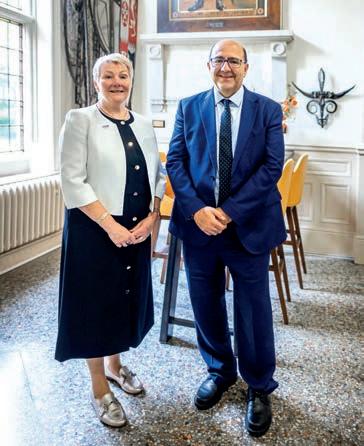
sustainability. CIOB’s work in EDI, building safety, modern slavery and social value all fit with the United Nations SDGs.
“Education is SDG 4, and this obviously is core to so much of the CIOB’s work – through apprenticeships, mentoring, the CIOB Academy, the Global Student Challenge and Tomorrow’s Leaders.”
CIOB, through its client engagement strategy, is ideally positioned to encourage SDG adoption in construction, Kagioglou believes.
“Mike Foy, during his presidency, did some great work to engage with clients and encourage them to promote professionalism through the sector, and that could be extended with the SDGs,” he says.
“Through the procurement processes, and the questions at prequalification, clients could ask questions about initiatives
Mike Kagioglou with CEO Caroline Gumble: ‘The UN SDGs fit with the goals in the CIOB corporate plan’
to end poverty, promote gender equality, reduce inequalities, how a contractor educates its workforce, what its modern slavery rules are, does it pay the minimum wage?
“Clients also can look at different alternatives when it comes to their building requirements. When presented with designs, what is the amount of waste generated through option A compared to option B? What are the operating costs likely to be and can we reduce them? How can we design the building so that it can repurposed or deconstructed in the future?”
Modern professionalism
The overarching theme of CIOB’s corporate plan is ‘modern professionalism’ and Kagioglou argues that his mantra of ‘challenging perspectives’ is central to this.
“Modern professionalism is about challenging siloed ways of working,” he says. “Challenging a narrow view of what a construction manager is responsible for. Challenging traditional routes into professionalism. Challenging old ways of attracting and developing talent. Challenging old techniques for putting together a building.”
And Kagioglou is likely to find plenty of support for his philosophy. Thanks to CIOB’s membership growth internationally, the institute now has an increasingly broad and diverse network of people – who like challenging perspectives. ●
20 | CONSTRUCTION MANAGEMENT JULY/AUGUST 2024 n Interview constructionmanagement.co.uk
REDPIX
Academia
There’s still a gap between academia and employers: on one side, we don’t see companies engaging with the research and innovation universities do; but then, academia is not always very good at explaining what the innovation is.
Gender balance
I championed this in Australia with Women in Engineering, and we worked with Multiplex on the new Western Sydney Airport where a high proportion of the construction managers were women. But there is still much work to do.
Retrofit
I’m involved with my university’s masterplan development for the next 10 years and we need a clear framework on these decisions. When we retrofit, we need to be sure we’re not generating more waste in the process and ending up with buildings that don’t meet our objectives and carbon reduction targets.
The UN Sustainable Development Goals and their relevance to construction
Mike Kagioglou explains how the targets adopted by UN members in 2015 have continuing relevance for the global construction industry

The 17 Sustainable Development Goals (SDGs) were created through the 2030 Agenda for Sustainable Development, adopted by all United Nations members in 2015.
Their aim is to achieve “peace and prosperity for people and the planet”, while tackling climate change and threats to biodiversity. The SDGs highlight the connections between the environmental, social and economic aspects of sustainable development.
Professor Mike Kagioglou highlights the following SDGs as having particular relevance to construction:
l Goal 9: Build resilient infrastructure, promote inclusive and sustainable industrialisation and foster innovation.
l Goal 11: Make cities and human settlements inclusive, safe, resilient and sustainable.
l Goals 13, 14, and 15 are about climate change, conservation and biodiversity. “These are all areas where our work has an impact, where CIOB has already put in a lot of groundwork, notably in highlighting the new rules about biodiversity net gain.”
But he notes that all the 17 SDGs apply to construction in some way, for example:
l Goal 1: End poverty in all its forms everywhere. “Are we sure that our supply chains are paying a living wage? Do the buildings we create reduce exposure of vulnerable people to climate-related extreme events?”
l Goal 3: Ensure healthy lives and promote wellbeing for all at all ages. “Are the buildings we construct keeping the occupants safe? Is the infrastructure contributing to reducing deaths and injuries from road traffic accidents?”
l Goal 4: Ensure inclusive and equitable quality education and promote lifelong learning opportunities for all. “Education and learning are core to the CIOB and should be for all construction companies.”
l Goal 5: Achieve gender equality and empower all women and girls. “There are some good EDI initiatives tackling this, but what impact are we really making towards the SDG target of ensuring women’s full and effective participation and equal opportunities for leadership in our industry?”
l Goal 8: Promote sustained, inclusive and sustainable economic growth, full and productive employment and decent work for all. “For example, the objective of modern methods of construction is not just about building faster, less expensively. It is about improving economic productivity.”
CONSTRUCTION MANAGEMENT JULY/AUGUST 2024 | 21 Interview n constructionmanagement.co.uk
Mike Kagioglou on…
Q&A: Approved Codes in new home construction
Construction quality of new-build homes is a growing concern. Here CM asks Sue Redding of the Chartered Trading Standards Institute how consumers are protected by the Approved Code Scheme

What is the Approved Code Scheme?
The Approved Code Scheme helps businesses to protect consumers with best practices. Originally set up by the Office of Fair Trading (OFT), the scheme is supported by the government and powered by Trading Standards, the local authority departments that enforce consumer protection legislation. The scheme’s
The Approved Code Scheme aims to drive up standards in new home construction
independence and association with Trading Standards is fundamental to its credibility.
The scheme is overseen by the Consumer Codes Approval Board (CCAB), to ensure independence from businesses and to protect consumers’ interests. The CCAB is set up as a community interest company (CIC) and the Chartered
Trading Standards Institute (CTSI) delivers administrative services on behalf of the CCAB.
Approved Code Scheme businesses are on the front line of the ongoing fight against rogue traders and other bad practices, helping the Trading Standards profession to protect consumers. The scheme aims to drive up standards and reduce consumer detriment in self-regulated sectors and encourage business to have a positive impact on consumers in their sector.
Overall, the Approved Code Scheme currently has 18 code sponsors with 21 different approved codes in a wide range of sectors which involve higher potential risks to consumers and larger consumer purchases and covers more than 80,000 businesses in the UK.
Who are the Approved Code Scheme sponsors in the new homes sector?
In the new homes construction and warranties sector, there are three major code sponsors, Consumer Code for New Homes (CCNH), Consumer Code for Home Builders (CCHB) and ICW Insurance Services, which operate consumer codes under the Approved Code Scheme and provide high levels of consumer protection, going above and beyond consumer law obligations.
Warranty providers under the Approved Code Scheme include
22 | CONSTRUCTION MANAGEMENT JULY/AUGUST 2024 n Technical constructionmanagement.co.uk

Advantage Home Construction Insurance (AHCI) and Ark Insurance Group. Over 10,000 new homebuilders are registered with the three major codes sponsors and more organisations are currently seeking code approval.
How does the scheme protect buyers of new homes?
The Approved Codes set out mandatory requirements that apply to all developers registered with the codes, to ensure that best practice is followed in the marketing and selling of new homes.
Approved Codes in the new homes sector cover the pre-contract stage, contract exchange, legal completion and after-sales service. Their key protections include:
l providing clear, detailed information to enable consumers to make informed decisions throughout the buying process with additional support for vulnerable consumers;
l pre-completion inspections with a professional adviser to tackle snagging issues;
l a 10-year warranty, with a builder required to deal with any defects in the first two years;
l the ability for buyers to cancel the agreement after exchange if substantial changes are made to their home that they don’t agree with;
l financial protection such as a full refund of the reservation fee within a 14-day cooling-off period and
The refreshed Approved Code scheme logo
Approved Codes sponsors:



Warranty providers:


deposit protection against a builder going into liquidation; and
l a free and accessible complaints and redress process with access to an alternative dispute resolution (ADR) scheme.
Our three major code sponsors provide ADR through the Centre for Effective Dispute Resolution (CEDR).
The CTSI is the competent authority which audits and approves ADR bodies in all non-regulated sectors under the Alternative Dispute Resolution for Consumer Disputes (Competent Authorities and Information) Regulations 2015.
How can consumers identify an Approved Code under the scheme?
Once approved, member businesses can then display the scheme’s Approved Code logo so that consumers can identify businesses that have consumers and customer service at the heart of their offering to inspire confidence and reassure consumers. Consumers should look for the Approved Code Scheme logo, which we have recently refreshed.
How are Approved Codes monitored?
The process for approving codes under the scheme is very detailed and robust. Code sponsors will only be approved if they can clearly demonstrate that they are committed to the reduction of consumer detriment and improving service standards.
The Approved Codes set out mandatory requirements that apply to all developers registered with the codes, to ensure that best practice is followed in the marketing and selling of new homes
Sue Redding, CTSI
Any code of practice approved under the scheme requires all member businesses to comply with the code sponsors’ code of practice, supporting business compliance.
Once approved by the CCAB, each code sponsor undergoes rigorous annual audits to ensure continuing compliance. More detail about the Consumer Codes Approval Scheme is on our website.
How effective are Approved Codes in protecting consumers?
Approved Codes are an important part of the consumer protection landscape as they offer alternatives to enforcement.
Unlike legislation, which can be slow and cumbersome to amend, codes of practice under the scheme can quickly adapt to changing market practices which means consumers are continually protected. They also reduce reliance on costly and resourceintensive legal or judicial routes to achieving redress.
We estimate that the scheme covers consumer spending of around £155bn and in the past year it has helped to recover more than £2.2m for consumers. l
Further information about the Chartered Trading Standards Institute is available at www.tradingstandards.uk. Email: CCAS@tsi.org.uk or adrenquiries@tsi.org.uk.
CONSTRUCTION MANAGEMENT JULY/AUGUST 2024 | 23 Technical n constructionmanagement.co.uk

Demonstrating competence in the building envelope sector
What does competency look like for the building envelope industry?
Su Butcher talks to Neville Grunwald from Wates, chair of the sector’s Joint Competence Initiative, and Ross Finnie from AccuRoof, who is on the governance steering group
24 | CONSTRUCTION MANAGEMENT JULY/AUGUST 2024 n Roofing & Cladding constructionmanagement.co.uk
Su Butcher: Demonstrating competence is one of the more complex challenges of the Building Safety Act and will take years to achieve. What does it mean and how will it be achieved in the envelope sector?
Neville Grunwald: The Building Safety Act applies to all buildings and requires us to meet the functional requirements of the building regulations and carry out the work with competent people.
Both of those things sound simple, but they are challenging. No one is showing us what good looks like; although there are three PAS documents setting out a framework, it is down to leading trade bodies to define the actual competence standards.
It’s been a tough four years for the supply chain. It is hard to ask them to now prove competency through additional training. Although there is installer training available, there is no such provision for designers, specifiers, procurers and site supervisors, all of whom have a direct impact on the quality and safety of buildings.
Ross Finnie: The JCI [Joint Competence Initiative] is trying to define a competency framework for the whole sector. It’s a huge task but we’re working to develop a solution, starting with a baseline competency test for the Building Safety Act. AccuRoof’s field technicians inspect
our roofs. They also train the subcontractors and are trained by the manufacturer. But who is to say the manufacturer is competent?
NG: The competence intent of the Building Safety Act is to prove skills, knowledge, experience and behaviour (SKEB) so it’s not just about training either.
SB: What is the JCI and how does it relate to the building safety landscape?
NG: The JCI is part of the Industry Competence Steering Group (ICSG) that reports to the Industry Competence Committee (ICC). We are working with them under their ‘super sector programme’ to develop installation competence standards for every type of roofing. SIG (AccuRoof’s parent company) is helping with that.
We were set up four years ago by 12 tier 1 contractors. We recruited trade bodies – National Federation of Roofing Contractors, Liquid Roofing and Waterproofing Association (LWRA), Institute of Roofing. We also involved clients, insurers, manufacturers, distributors and specialist subcontractors of all sizes; they all have different views on what’s necessary and how to make it work.
SB: Will the JCI approach become the recognised measure of competence for envelope suppliers?
NG: Yes – we’ve all got to work together to make a single set of standards; more than one avenue

The framework will become the recognised measure of competence for envelope suppliers
People will need to demonstrate their competence with a regular test as part of a code of conduct
Ross Finnie, AccuRoof
will just create confusion. We’re a good way there already: the ICC and ICSG chairs refer to us the leading body for competence in the building envelope sector. We need to keep pushing to get the standards set, and then start thinking about training gaps. How will training work? Well, my career spans 37 years in the industry – after all this time how will I find all my CPD and manufacturer training certificates? That’s not practical. The baseline competency test the JCI is developing will provide a way to prove your previous learning and this can be used as a foundation to build upon with additional training and CPD. Competency isn’t a static thing; it needs to continuously evolve.
RF: Not to mention legislative changes. People will need to demonstrate their competence with a regular test as part of a code of conduct, with measures in place to train everyone and keep them aware. Collaborating with the JCI has certainly helped us demonstrate our commitment to meeting competence requirements.
SB: What will this mean practically for manufacturers, designers and installers?
NG: Principal contractors and principal designers and their subcontractors and suppliers will have to prove their SKEB, so we don’t get a repeat of Grenfell, where the
CONSTRUCTION MANAGEMENT JULY/AUGUST 2024 | 25 Roofing & Cladding n constructionmanagement.co.uk
architect was pushed outside its field of experience. The requirements for construction haven’t really changed much, as the industry should always have been working to the building regulations, which includes competence. What’s changed is that the government are now holding us to account via the regulator.
SB: Do you think that the contractual arrangements will change? Does this mean the end of design and build?
NG: Design and build is not the enemy – the enemy is designing the project as we are building it. Ross and I have been on so many roofs where, for all the right reasons, someone has done the wrong thing. It’s usually because the architect or installer didn’t tell AccuRoof about an issue so they couldn’t address it. The installer goes on site and thinks, “well, I’ll just fix it”. It’s these problems on site that lead to failures in the building envelope that can later cause health issues for the occupants. That’s why I really admire the FIS (Finishes and Interiors Sector) who
are promoting the idea for installers to use “the responsible no”.
RF: We are getting involved earlier in roofing projects, in a more collaborative effort. A little more time up front to walk through the design during RIBA Stages 3 and 4 so we don’t miss any of those critical details and can address them at the right time.
SB: This is quite a culture change then?
NG: You’re dead right. One key part of competency is knowing where your competency stops. I won’t sign off a passive fire protection scheme because I’m not a fire engineer – it’s just the same with roofing. I’m stretched across a range of disciplines, but Ross Finnie and his team are far more focused, so when they say that’s not the best solution, I’d be a fool not to listen. We’re trying to build a team; the better our supply chain is, the easier my life becomes. A rising tide lifts all boats.
RF: For example, architects are defined by their designs, and they

A key part of competency is knowing where your competency stops. I won’t sign off passive fire protection because I’m not a fire engineer
Neville Grunwald, Wates
look at things from that perspective. But we’ve got to have the strength to say when something doesn’t work. We had a project like this where the architect wanted to bring a single-ply membrane down to ground level and we walked away because it wouldn’t work. The architect took on another advisor, but the test rigs failed. They came back to us for a different solution, so in the end it was in everyone’s interests to say no.
Problems on site often stem from design changes to the envelope during the build

NG: No one will thank you for providing a failing building. The idea that we can avoid confronting a bad decision won’t save us from an appointment with someone in a curly wig sometime in the future.
SB: Where can people find out more? NG: We’ll be registering membership organisations, in the next couple of months, and launching a website. People are welcome to get in touch with me via LinkedIn in the meantime. The JCI White Paper is available on the Council for Aluminium in Building (CAB) website. In addition, we have PAS Flex 8670 for the overarching competency framework, plus PAS 8671 for the principal designer role and those with designer responsibilities and PAS 8672 for the principal contractor role and those with contractor responsibilities. ● Su Butcher is director of Just Practising and was Digital Champion of 2023 at the Digital Construction Awards.
26 | CONSTRUCTION MANAGEMENT JULY/AUGUST 2024 n Roofing & Cladding constructionmanagement.co.uk

ISG restores the pride of Penzance
The Grade I-listed Penzance Market House is undergoing a vital roof restoration, courtesy of ISG. Will Mann reports from the far west of Cornwall

The Penzance Market House dates from 1838 and its distinctive domed roof dominates the skyline of this Cornish port town.
But since the beginning of the year, the Grade I-listed building – some 34m high, 24m wide and nearly 100m long – has been hidden inside a giant temporary scaffold structure wrapped
in fetching pink sheeting, while vital heritage repairs are carried out. Wear and tear over the years had led to water ingress and damage inside the vacant eastern end of the building and the basement. The western half of the building has been occupied for 99 years by one of the UK’s top five retailer banks, which brought in its construction
framework partner ISG to assess the damage, carry out interior repairs, and scope out the works required to the roof and building fabric. ISG progressed this work through 2021 and 2022, but after a drone survey and closer investigation of the roof condition, it became clear that this would be a bigger job than first expected.
28 | CONSTRUCTION MANAGEMENT JULY/AUGUST 2024 n Roofing & Cladding constructionmanagement.co.uk
Aerial shot of Penzance Market House in January during scaffold erection
Height in metres of the scaffold structure covering the domed roof

“It was evident that the lead was past its sell-by date,” says Matt O’Hara, ISG site manager on the project. “Originally we were planning patch repairs, but after advice from lead specialists and English Heritage, the only solution was to replace the lead on the whole dome head.”
Strengthening timber
It wasn’t just the lead that was damaged. The Market House looks like a typical Cornish granite building, but the structure above ground and first floor level is timber, including the dome and roof over the eastern end of the building. Some of the timber structure had rotted and needed strengthening. The total project cost is £1.7m.
“I’ve worked with the bank for 15 years on many of their branches and offices, but this is a project unlike any other,” says O’Hara. “We are working with local historians, Historic England and the council planning authorities to understand the original construction of the building, and we are carrying out like-for-like repairs with the same materials.”
Leadwork specialist EWN is replacing the lead roof sections.
“The Market House is like a smaller version of St Paul’s Cathedral roof – but it’s a bit windier here!” says director Elliot Newman.
A challenge for EWN is shaping the lead to fit the dome – the process known as bossing.
Penzance Market House in 1838
Matt O’Hara on the pitched roof. Timber joists nearly 200 years old have been used for the repairs
Penzance Market House
l Value: £1.7m
l Main contractor: ISG
l Programme: January to July 2024
Key suppliers
l Joinery repairs and decorations: Jobson Decorators
l Doff cleaning and pointing: Capital Stone
l Lead specialist: EWN
l Scaffolding: Chris Sedgeman
“We have created 10 different shaped moulds to reflect the curve of the dome – you obviously need a different form at the top of the dome where it narrows into the octagonal lantern compared to at the bottom where it’s wider,” Newman explains.
“We can’t use hot works here because of the heritage status and fire risk so these are created away from the site by joiners. We boss the lead using the mould in the hot works zone, and then bring the lead back to install on the roof.
“The original lead rolls were too large, probably about 800mm wide, and they’d expanded and contracted with the weather, and cracked in places, which led to the leaks.
Matt O’Hara, ISG
“The new lead rolls will be the standard 450mm. There were no regulations in the days when the roof was built so we’re bringing it up to today’s standards. We’re also fitting extra clips to hold them in place, which we wouldn’t do typically but given the weather conditions here, a ‘belt and braces’ approach is sensible.”
The sand-cast lead is a dull grey appearance at present, but Newman explains that once it has rained, the dome will change colour to “a light grey, which is what the original roof would have looked like”.
The dome roof sits on an octagonal drum ringed by 16 Doric columns which are also timber and Originally we were planning patch repairs, but after advice from lead specialists and English Heritage, the only solution was to replace the lead on the whole dome head
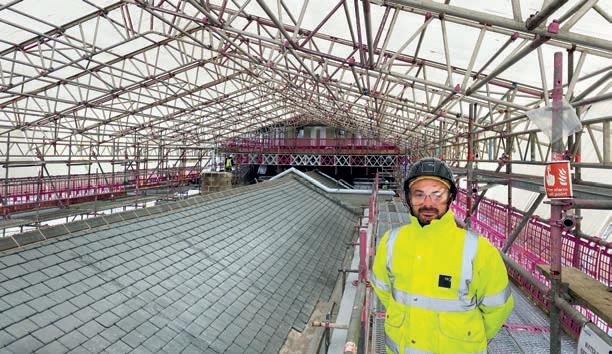
CONSTRUCTION MANAGEMENT JULY/AUGUST 2024 | 29 Roofing & Cladding n constructionmanagement.co.uk
MORRAB LIBRARY
38
have required repainting, this time with a specialist heritage paint that is breathable. O’Hara notes that the condition of the columns is “incredible” given that only the paint was protecting the timber from the elements for nearly 200 years.
Four wooden ‘scroll’ details around the base of the drum are being carefully repaired, in one case off site, by a specialist in London.
The pitched roof on the eastern side of the building has also required repairs, with around 100 new slates fitted and the flashing replaced. “Previously the gullies had been getting blocked, and where the flashing hadn’t been fitted properly, water was running


Erecting the scaffolding
ISG’s contract includes repainting and window repairs
into the building and down into the basement,” O’Hara says.
ISG has had to strengthen one of the main joists that was damaged by leaks. “We found a local sawmill, certified by English Heritage, and amazingly they have the same timber from nearly 200 years ago,” explains O’Hara. “That’s where all the timber comes from that we’re installing here.”
Building fabric condition
ISG has cleaned the Market House stonework, using a steam cleaner, which first required four different pressure patch tests to check it would not damage the stone or mortar.
“Where mortar had crumbled and failed, a sample was taken away for laboratory analysis, with the heritage team agreeing a replacement lime mortar mix to use which is as close to the original as possible,” adds O’Hara.
The original sash windows are being repaired and glazing replaced where necessary, typically where the beading had crumbled.
“The condition of the building fabric is generally worse on the seaward, west-facing side of the building, where the weather comes from,” O’Hara says.
He is logging the condition of all the assets on the building which will be handed over to the client on completion.
30 | CONSTRUCTION MANAGEMENT JULY/AUGUST 2024 n Roofing & Cladding constructionmanagement.co.uk

O’Hara is Kent-based and travels down every couple of weeks to spend a few days in Penzance on the project. He joined construction in 2005 after a football career with Gillingham FC’s academy was cut short by injury. He started out as a shopfitter, taking an apprenticeship, then moved up to site management, joining ISG and becoming a specialist on its retail bank work.
He says the heritage aspects of the project have been a terrific learning experience. “We’ve had great advice from Catherine Marlow at Historic England, Chris Miners at English Heritage, local historian Eric Berry, plus Hannah Williams and Colin Buck from Cornwall Council,” he says.
We’re fitting extra clips to hold the lead rolls in place – given the weather conditions here, a ‘belt and braces’ approach is sensible
Elliot Newman, EWN
The replacement lead was bossed using 10 different shaped moulds
Elliot Newman of lead specialist EWN at the top of the domed roof
As well as working with heritage experts, O’Hara was able to give work to a homeless person who used to sleep on the steps of the Market House, and asked if there was any work available. “We gave him some labouring work and helped him get his CSCS card, and since then he’s managed to save some money and get himself somewhere to live and move into full time employment,” O’Hara says.
By the end of July, the 24-week construction programme will be coming to an end, the scaffolding should be ready to come down and the restored Market House will be back on show in the heart of Penzance. ●

‘This is the first time we have ever covered a dome’ Chris Sedgeman runs the contractor with the distinctive pink scaffold sheeting

Facilitating the whole Market House project is the 38m-high temporary works structure which encapsulates the building and runs to 17 floors of scaffolding. It was erected by Chris Sedgeman Scaffolding, a Penzance firm but a major national player.
Managing director Chris Sedgeman (pictured above), from up the road in St Just, came up with the idea of pink branding 30 years ago, meaning that building sites all over the country feature his distinctive scaffold sheeting.
“We’ve put scaffolding around a lot of unusual buildings, but this is the first time we have ever covered a dome,” says Sedgeman.
“It is a complex building to put scaffolding around, because of the circular shape of the dome, and the ins and outs of the facade. But we model the scaffolding digitally first and with this modular scaffold system we can work to a tolerance of 50mm.
“The other advantage of the modular system is that it provides clear access for ISG’s team and the trades to get around the structure.”
The structure was erected between October to January, using a winch system. Putting up the scaffold and managing site logistics has been “challenging”, says O’Hara.
As the Market House is in the middle of Penzance, on the town’s busy Market Jew Street, no road closures were permitted, and all of the deliveries had to come in at the eastern end of the site.
CONSTRUCTION MANAGEMENT JULY/AUGUST 2024 | 31 Roofing & Cladding n constructionmanagement.co.uk

CSCS Industry Accreditation renewal deadline passes
A package of financial and training support remains available to those with CSCS cards issued under Industry Accreditation
onstruction Skills Certification Scheme (CSCS) cards issued through Industry Accreditation (IA) can no longer be renewed using this route after the deadline passed on 30 June. All remaining cards obtained under IA will expire on 31 December 2024, when the IA route will be discontinued entirely.
CHistorically, IA saw CSCS issue cards on the back of a recommendation from an employer rather than the achievement of a recognised qualification. CSCS stopped issuing new cards under IA in 2010 but until 2020 the rules allowed existing IA cardholders to renew their cards for a full five-year term. Many of those who need to renew will be able to use an existing vocational or construction-related academic qualification, while professional body memberships such as the Chartered Institute of Building (CIOB) are also accepted as part of CSCS card applications.
Alternative qualification routes
Those without such credentials will need to register for the appropriate qualification using the package of financial and training support available, as provided by a crossindustry task group set up to assist IA cardholders and employers during the transition.
The support offered includes enhanced Construction Industry Training Board (CITB) grant funding for levy payers and flexible assessment options ensuring individuals do not need to attend college – a common misconception among remaining IA cardholders.
The strategic direction of the scheme is designed to mirror that of industry and help facilitate a fully
32 | CONSTRUCTION MANAGEMENT JULY/AUGUST 2024 n Partnership constructionmanagement.co.uk
qualified workforce in line with the Construction Leadership Council (CLC) recommendations.
The CLC recommendations, updated earlier this year, require the industry to “specify and promote card schemes carrying the CSCS logo” and that “industry card schemes operate with nationally recognised qualifications in place for all occupations”.
The recommendations also highlight that cards will not be issued for those visiting site to carry out a non-construction-related role.
This means that individuals who are now in office-based roles or simply visiting site to attend a meeting in a site office do not require a card.
Tackling misconceptions
Alan O’Neile, director of communications at CSCS, explains: “Industry has had several years to absorb the change and migrate individuals off IA cards. However, some remain under the misapprehension it will involve experienced workers forced off
site to return to college and complete a qualification
“The reality is entirely different. The process of gaining an NVQ is not as onerous as many might think. Experienced workers are not required to attend college and it might be as simple as completing an onsite assessment, putting together a portfolio of experience gained or having a skills assessment interview.
“In addition, CITB has increased the grants for supervision and management VQs to £1,250 and £1,500 respectively to help support with the phasing out of IA.”
A large percentage of those initially affected have already moved off IA cards, with many of the remainder likely to already have the vocational qualifications necessary to retain their cards, such as City and Guilds Craft or Advanced Craft certificates. Alternatively, they may be holders of degrees or professional body memberships, allowing them to apply for the Academically or Professionally Qualified Person cards respectively.
Affected cards will have the term ‘Industry Accreditation’ printed on the reverse


The process of gaining an NVQ is not as onerous as many might think. Experienced workers are not required to attend college
Alan O’Neile, CSCS
A fully qualified workforce
IA card holders who no longer attend site or are in non-constructionrelated occupations do not require a card, so can allow their card to expire.
O’Neile continues: “CSCS is committed to playing its part in delivering the fully trained and qualified workforce industry needs. We would urge employers, trade associations, awarding organisations and training providers to put plans in place to support the remaining affected workers ahead of December 2024.”
Over recent years, safety and standards have been improving in construction and, following the introduction of the Building Safety Act, the expectation is that workers must be able to prove competence and part of that process is the achievement of a recognised qualification.
The withdrawal of IA is the latest move by CSCS to work towards the goal of a fully qualified, but not necessarily fully carded, workforce, following the removal of the Construction Site Operative, Construction Related Occupation and Site Visitor cards ● Those impacted by IA can get further information and details on the support available, the qualifications required for specific occupations and the different assessment routes offered by training providers by visiting: CSCS.uk.com/industryaccreditation.
CONSTRUCTION MANAGEMENT JULY/AUGUST 2024 | 33 Partnership n constructionmanagement.co.uk
In association with
Saudi legal sands shift
A new law in the kingdom has significant implications for construction contracts. The key points are explained by Kiran Giblin, Andrew Sarraf, Ali Auda and Cameron McPheely of law firm Mayer Brown
Saudi Arabia’s new Civil Transactions Law entered into force on 16 December 2023. It’s a cornerstone of the kingdom’s broader Vision 2030 initiative, which aims to invigorate the economy by encouraging foreign investment and modernising the kingdom’s legal framework. The law affects contracts generally in the kingdom, but construction is particularly suited to take advantage of it.
Construction is booming there with ‘giga-projects’ like Neom, the vast Red Sea tourism developments, the New Murabba projects and more. Industry output is expected to grow annually at a rate of 4% between 2024 and 2026.
The Civil Transactions Law, comprising 721 articles and underlying Sharia law maxims, includes various provisions which expressly provide for muqawala (construction) contracts.
Such provisions aim to encourage consistency in contractual interpretation and thus promise a more predictable environment for contractors and investors.
Interpretation of contracts
The law is not a mere codification of Sharia laws, and nor is it a carbon copy of laws in similar
Islamic jurisdictions. Instead, it’s a clear and defining contractual regime in the kingdom.
Article 1 confirms the hierarchy of applicable provisions, with the articles under the new law ranking as foremost important. The relevant Sharia law maxims apply only where the statutory provisions in the articles are silent.
Specific rules for the interpretation of contracts are set out in Article 104, among others.
These prescribe that contractual provisions ought to be construed literally and in accordance with the parties’ original will and intent.
Further, any interpretation of the terms must not act to contradict another term under the contract. Parties should not, therefore, attempt to rely on an individual contractual term in isolation as such an approach will rarely be enforced by a presiding court or arbitrator.
Limitation periods
Under the old law, no prescription or limitation period existed with respect to a party’s right to bring a claim.
The new law, specifically Articles 295 to 297, sets out relevant limitation provisions applicable to contractual claims:
l Article 295 confirms that the right for legal action to be heard
Provisions aim to encourage consistency in contractual interpretation and a more predictable environment for contractors
will be unenforceable after 10 years (except where the law provides otherwise) – this limitation period will typically apply to claims under construction contracts;
l Article 296 provides a five-year limitation period for claims relating to professional fees and renewable rights; and
l Article 297 provides a short one-year limitation period for claims under certain consumer and employment contracts.
Crucially, when calculating the relevant limitation period, parties should be aware that any period runs according to the Islamic Hijri calendar (not the Gregorian calendar), which consists of either 354 or 355 days per year.
Termination of contracts
Circumstances and conditions for termination of contracts are markedly clearer under the new law. Article 94 provides that a contract cannot be revoked or amended except by agreement of the parties or by virtue of a statutory provision. If a contract is rescinded for any reason, the parties are to be returned to the condition in which they were before the contract was entered into. If this simply is not possible, as would often be the case on construction projects (given the nature of the
34 | CONSTRUCTION MANAGEMENT JULY/AUGUST 2024 n Global constructionmanagement.co.uk
Construction industry output in Saudi Arabia is expected to grow annually at a rate of 4% between 2024 and 2026

works), then a court or arbitrator may award compensation as appropriate. However, most construction contracts in the kingdom are based on standard form contracts (such as FIDIC or JCT) and so will typically contain specific termination provisions. Such provisions will continue to take effect ahead of certain generic termination provisions under the new law.
Damages and liquidated damages
One of the most definitive changes under the new law is the added certainty surrounding liquidated damages. Under the new law, liquidated damages are permissible. However, the quantification of such damages is subject to Article 179, which expressly allows a presiding court or arbitrator to reduce the amount of liquidated damages:
Construction work in Dammam, Saudi Arabia, on the Persian Gulf
The new law is clear that if both the contractor and employer are equally responsible for a period of delay, then they should be equally responsible for the resulting losses
(i) if such amount is considered excessive; (ii) if it can be shown that no loss has in fact been suffered; and/or (iii) if a relevant obligation has been at least partially performed. Relatedly, Articles 136 to 139 and 180 concern damages to be applied where there is a breach of contract. In short, these provide that an obligor should only pay compensation for foreseeable damage as at the time the contract was entered into.
Lastly, Articles 128 and 172 confirm that any damages owed to a creditor will be proportionately reduced by the extent to which that creditor, through his own fault, has contributed to the damage arising from the breach. As such, damages shall be apportioned among the parties as appropriate. This approach is particularly relevant when considering commonly deployed arguments of concurrent delay – the new law is clear that if both the contractor and employer are equally responsible for a period of delay, then they should be equally responsible for the resulting losses.
Conclusion
In light of the new law, parties can expect greater certainty as to the application and enforcement of provisions under their construction contracts. Notwithstanding this, the strict emphasis on the literal meaning of terms acts to reinforce the importance of unambiguous and clear contractual drafting. ●
CONSTRUCTION MANAGEMENT JULY/AUGUST 2024 | 35 Global n constructionmanagement.co.uk
4

What you will learn in this CPD
The fire testing standards for roofs
Best practice guidance for achieving a fire-compliant green roof
Which green roofs are exempt from testing

CPD: Fire safety guidance for green roofs
How do fire safety regulations apply to green roofs? In this CPD, Mark Harris from the Green Roof Organisation (GRO) explains how to achieve compliance
Compliance and competence have become two key drivers in today’s construction industry following the Grenfell Tower fire and the 2022 Building Safety Act. Roofing is no exception. Let’s look at the fire performance requirements for roofs. The first thing to be aware of is nothing has significantly changed since the fire performance testing and classification standards for roof systems were introduced in 1958. BS 476 Part 3 has been updated a few times over the past 65 years and is still referenced today but is likely to be removed in the next update of the building regulations.
The test result and classification report are only valid for the system as tested, which means the actual thickness of each component
Fire testing standards for roofs
The replacement of BS 476 Part 3 began in 2007 with the introduction of the European classification standard BS EN 13501-5, which classifies roof systems into five categories depending on the performance of the material (see box, p37).
It is important to note that both the fire performance testing standard CEN/TS 1187:2012 Test methods for external fire exposure to roofs and the classification standard BS EN 13501-5
Classification using data from external fire exposure to roofs tests require full roof system assessment. That means structural deck, air
and vapour control layer (AVCL), insulation, waterproofing and the roof finish, if there is one above the waterproofing.
The test result and subsequent classification report are only valid for the system as tested, which means the actual thickness of each component including the insulation.
Alternatively, where multiple tests of a similar buildup are passed, an EXAP (extended field of application) report to PD CEN/TS 16459:2019 External Fire Exposure of Roofs and Roof Coverings applies. Extended applications of test results from CEN/TS 1187 will cover various permutations.
36 | CONSTRUCTION MANAGEMENT JULY/AUGUST 2024 n CPD constructionmanagement.co.uk

However, there are limitations with testing, such as deck type and the thickness of roof assemblies that can be tested. In these and other circumstances judgement may be required, and while the ‘as built’ should match the ‘as tested’ it may be reasonable to accept that the ‘as tested’ is the accepted worst case compared to the ‘as built’.
When looking at classification reports it is important that they relate to Test 4 classification (t4) as EN 13501-5 also contains fire performance test standards for other European countries (Germany, France and Scandinavia) and these t1, t2 or t3 classifications are not valid for UK fire compliance.
Green roof fire considerations
Testing a green roof to these standards is, however, difficult due to the sample conditioning requirements that require the test samples to achieve a stable dry weight within two weeks, something a green roof substrate struggles to achieve as its function is to hold moisture.
Fire testing a green roof is difficult as its function is to hold moisture
European Classification System BS EN 13501-5
Understanding the different tests and roof classifications
BS EN 13501-5 refers to four separate roof testing methods that are used to measure the fire safety of roofs, of which test 4 is the most thorough. Test 4 evaluates the performance of a roof under thermal attack with burning brands, wind and radiant heat and gauges external fire spread and penetration by fire. It includes a preliminary test which involves examining one specific specimen plus three other specimens are assessed in a penetration test.
Test 4 is used for the following classification system for roofs and roof coverings exposed to external fire (where the suffix t4 indicates that test 4 is to be used).
l BROOF(t4): The highest rating of roof classification. During the test, there will be no penetration of the roof system within 60 minutes. In addition, during the preliminary test, after withdrawal of the test flame, the selected specimens will burn for
How roof specimens are tested for fire safety
*Angle ø = 45° for inclined test ø = 0° for horizontal test
Edge 'A' Roof specimen
Mica window
Specimen cover Suction pipe Trolley
less than five minutes, and the flame spread will be less than 0.38m across the area of burning.
l CROOF(t4): No penetration of the roof system within 30 minutes. During the preliminary test, after withdrawal of the test flame, the specimens will burn for less than five minutes and the flame spread will be less than 0.38m across the burning region.
l DROOF(t4). The roof system will be penetrated within 30 minutes but this does not occur in the preliminary test. Instead, the specimens will burn for less than five minutes and have a flame spread of less than 0.38m across the region of burning.
l EROOF(t4): The roof system is penetrated within 30 minutes but is not penetrated in the preliminary test. However, the flame spread is not controlled.
l FROOF(t4): This is the lowest rating of roof classification. No performance determined.

Surface combustion heaters
CONSTRUCTION MANAGEMENT JULY/AUGUST 2024 | 37 CPD n constructionmanagement.co.uk
Directionofflame
ø* SOURCE: BAUDER
Fire breaks should also be installed in 1m strips every 40m across extensive green roofs
What assists with this challenge is the Department of Communities and Local Government (DCLG) August 2013 document, Fire Performance of Green Roofs and Walls for best practice guidance on achieving a fire-compliant green roof.
However, again, life is not simple. The DCLG guidance references parts of the Approved Documents that no longer exist, do not relate to the Scottish Technical Handbooks and are in places contradictory and unclear.
To help clarify, demystify and update the DCLG guidance, the Green Roof Organisation (GRO) has written an updated guidance document.
In summer 2024 GRO will publish both its analysis of the DCLG guidance and its updated GRO fire compliance guidance.
Supporting this will be the GRO fire assessment programme in which GRO members will be able to submit their green roof systems for compliance assessment, with confirmation of compliance resulting in a unique reference number and GRO fireassessed logo.
The DCLG’s Fire Performance of Green Roofs and Walls sets out the DCLG’s ‘compliance without further testing’ guidance for green roofs in two sections relevant to internal fire spread and external fire spread.
Fire/wind/maintenance break
Perimeter details
Abutment to a combustible or non-combustible external wall with opening windows
Abutment to a combustible or non-combustible external wall with non-opening windows
Abutment to a combustible or non-combustible parapet wall
Abutment to a retaining angle at a verge
Abutment to a retaining angle at an internal gutter
Roof area penetrations and detail
Abutment to an opening rooflight
Abutment to a non-opening rooflight
Abutment to a non-fire sealed pipe penetration, rainwater outlet, fall arrest post, etc
Abutment to a fire sealed pipe penetration, rainwater outlet, fall arrest post, etc
500mm50mm500mm40mm
300mm50mm300mm40mm
300mm50mm500mm40mm
300mm50mm300mm40mm
300mm50mm300mm40mm
Fire/wind/maintenance break
500mm50mm500mm40mm
300mm50mm300mm40mm
500mm50mm500mm40mm
300mm50mm300mm40mm
In the case of a green roof, including one with a blue roof, ‘compliance without further testing’ status is provided by DCLG guidance
DCLG Regulation B3: Internal
The document states: “Whilst fire spread to a green roof via penetrations such as roof lights, pipes or vents in the roof is not in itself a breach of requirements B1 to B5, it is recommended that fire breaks are provided around such penetrations so that basic maintenance procedures can be carried out.”
It adds: “Fire breaks should consist of paving slabs or non-vegetated strips of pebbles with a depth of 75mm and diameter between 20 and 50mm for a width of 500mm. Larger pebble sizes are preferred as this leads to less vegetative growth.”
Given that the guidance states that fire breaks are not required for fire performance purposes and that Commission Decision 2000/553/EC gives ‘deemed to satisfy’ status to 50mm of gravel ballast, GRO will be updating its guidance to the recommendations in the table (left).
The GRO guidance is further supported by the Department for Education green roof specifications requiring 50mm of gravel 300mm wide. (50mm deep and 300mm wide gravel breaks have been used across Europe for decades.) Note that gravel breaks also perform the function of resisting wind scour and providing vegetation breaks.
300mm50mm300mm40mm
Abutment to a non-deck penetrating fall arrest post300mm50mm300mm40mm Roof step (above and below the step)
Fire breaks should also be installed in 1m strips every 40m
38 | CONSTRUCTION MANAGEMENT JULY/AUGUST 2024 n CPD constructionmanagement.co.uk
40
Gravel width Gravel depth Paving width Paving thickness
Gravel width (min) Gravel depth (min) Paving width (min) Paving thickness (min)

Understanding building regulations and Approved Documents
The four nations of the UK publish statutory instruments (legal requirements) for the construction of dwellings (homes) and non-dwellings. These documents, the building regulations, set the minimum legal requirements for fire safety. These regulatory documents are broken down into two building type groups: dwellings – flats, apartments, houses etc; non-dwellings – all other buildings.
across extensive green roofs. These should consist of paving slabs a minimum 40mm thick or non-vegetated strips of pebbles with a depth of 50mm and diameter between 20 and 40mm for a width of 500mm.
Always consider the action of wind uplift on buildings, which may require larger diameter/higher ballast weight of gravel or heavier paving slabs of a wider margin to prevent wind scour of the green roof growing media.
The regulators in England, Wales and Northern Ireland also publish a series of Approved Documents (Document B Volume 1 Dwellings and Volume 2 Buildings other than dwellings), providing guidance on complying with the statutory (legal) minimum requirements of the building regulations. In Scotland,the regulator publishes Technical Handbooks (Domestic and Non-Domestic) to serve the same purpose.
DCLG Regulation B4: External
A fire test classification report is only valid for an exact buildup. When installing a roof system, it must be supported by a report that matches what is being constructed. Where a roof system has a finish – such as a green roof, a blue roof, artificial grass, porcelain tiles or a running track – the test must include those elements in the classification report. However, in the case of a green roof, including one with a blue roof, ‘compliance without further testing’
Fire breaks can consist of nonvegetated strips of pebbles
CPD Questions
1) What is the European standard used for classification of construction products and building elements, including roofing?
a) BS EN 13101-5
b) BS EN 13301-5
c) BS EN 13501-5
2) What gravel break is included in Department for Education green roof specifications?
a) 50mm of gravel, 300mm wide
b) 60mm of gravel, 500mm wide
c) 70mm of gravel, 500mm wide
3) Fire breaks such as paving slabs or strips of pebbles should be installed across extensive green roofs to what requirement?
a) 450mm strips every 20m
b) 600m strips every 30m
c) 1m strips every 40m
4) BS EN 13501-5 refers to four separate roof testing methods that are used to measure the fire safety of roofs. Which is the most thorough?
a) Test 1 b) Test 4 c) Test 6
5) Which is the highest rating of roof classification under BS EN 13501-5?
a) BROOF(t4)
b) CROOF(t4)
c) DROOF(t4)
To test yourself on the questions above, go to www.construction management. co.uk/cpd-modules
status is provided by DCLG guidance. This states that the use of a growing medium with a minimum 80mm of settled depth and an organic content not exceeding 50% by volume is deemed to achieve BROOF(t4) – the highest rating – independently of the roofing system below, provided the structural roof deck complies with the requirement for Regulation B3. This exemption from testing does not apply to any other surface finish, a lesser depth of growing medium or a higher organic content. ●
CONSTRUCTION MANAGEMENT JULY/AUGUST 2024 | 39 CPD n constructionmanagement.co.uk

What you will learn in this CPD
The difference between patent and latent defects
How these defects impact contractors and clients
Current UK legislation and guidance relating to defects
CPD: Patent and latent defects
In this CPD, Anthony Walker reviews the differences between patent and latent defects in buildings and how they impact contractors and clients
here are known knowns; there are things we know we know. We also know there are known unknowns; that is to say we know there are some things we do not know. But there are also unknown unknowns – the ones we don’t know we don’t know.”
Former US secretary of defence
Donald Rumsfeld, 12 February 2002
The above quote encapsulates the concept of knowledge and uncertainty, particularly relevant in the complex world of construction defects. Despite meticulous planning and careful execution, defects can still occur, impacting a building’s quality, safety and longevity.
Patent and latent defects: examples
l Patent defect: Damp and mould were present in the basement of a newly built office block due to a poorly designed drainage system. The patent defect was identified and resolved through a successful claim for compensation against the contractor.
l Latent defect: Structural issues due to inadequate foundations became apparent several years after completion of a new hospital. A survey was carried out and specialist advice sought. The latent defect was resolved through a successful claim for compensation against the contractor.
Understanding defects
It’s important to distinguish between two types of defects: patent and latent.
Patent defects are readily observable ‘known’ flaws, visible to the naked eye or detectable through a routine inspection. A patent defect wouldn’t typically require any specialised equipment to be identified. Some examples include cracks in walls or floors, improperly installed windows or doors, water leaks, uneven floors or ceilings and missing or damaged materials.
In contrast, latent defects are hidden ‘unknown’ flaws – and potentially more complex and problematic. These are not immediately apparent and may take months or even years to become noticeable, sometimes manifesting only after significant damage.
They often require a more in-depth inspection, more specialised knowledge and sometimes testing to uncover. Some examples include insufficient foundations, understrength materials, defective waterproofing, faulty wiring, leaking pipes and improperly installed roofing.
The impact of defects
Both types of defects pose problems, but in different ways:
l For contractors: Failure to address patent defects promptly can lead to delays, reputational damage and financial penalties. In some cases, legal action may be taken by the client seeking reimbursement for repairs or compensation for inconvenience.
Latent defects tend to cause even greater issues since they are not immediately detectable, resulting in costly repairs and potential health hazards, potentially leading to disputes between contractors and clients over liability and responsibility for repairs.
l For clients: Patent defects can be frustrating and inconvenient, requiring repairs that eat into budgets and disrupt planned schedules, but they are identifiable and can be addressed relatively easily.
Latent defects, on the other hand, present a greater challenge, often needing expensive repairs due to structural instability or safety hazards, and may cause a significant decrease in the property’s value.
40 | CONSTRUCTION MANAGEMENT JULY/AUGUST 2024 n CPD constructionmanagement.co.uk
" T






CONSTRUCTION MANAGEMENT JULY/AUGUST 2024 | 41 CPD n constructionmanagement.co.uk

Legislation and standards on defects
Several key pieces of legislation and guidance pertain to defects in the UK, including:
l Latent Damage Act 1986: This establishes time limits for bringing claims related to latent defects, providing clarity when clients can seek legal recourse for latent defects discovered after project completion.
l Limitation Act 1980: This sets out limitation periods. The starting point for measuring limitation periods is the date on which the cause of action accrues. In this context, ‘cause of action’ is simply a reference to the material facts that allow the claim to be made. For example, for a claim in a contract, the cause of action is the date on which the breach of contract occurs.
l Defective Premises Act (DPA) 1972: This imposes a duty of care on those involved in constructing or working on
Understanding liability periods
The concept of a ‘latent defects liability period’ is crucial for understanding contractors’ responsibilities. This period, as set out in the Latent Damage Act 1986, is typically six years from the completion of a construction project, but it can be extended to 12 years
a dwelling. It is worth noting that the Building Safety Act has extended the liability period for claims under the DPA from six years to 15 years for claims for works completed after 28 June 2022 and to 30 years retrospectively for claims regarding works completed before 28 June 2022. Previously, this only covered claims related to new construction, but now it also covers claims relating to refurbishment and remedial works to existing properties.
l Building Regulations: These set standards for the design and construction of buildings to protect people’s safety, health and welfare in or about those buildings. They also set standards for accessibility, water use, energy use and security.
if the contract was executed as a deed (a formal legal document).
The act also provides an additional three years in certain circumstances to claim for latent damage. Section 14B also imposes an overall long-stop date of 15 years from the breach of duty resulting in the damage.
Latent defect surveys provide a comprehensive understanding of existing defects, their causes, necessary repairs and estimated costs
Latent defect
surveys
Building owners or managers are recommended to commission a latent defect survey before the liability period expires.
These surveys, typically carried out by a building surveyor, provide a comprehensive understanding of existing defects, their causes, necessary repairs and estimated costs. This information can be invaluable for future financial and legal discussions.
A typical latent defect survey involves:
l Reviewing building documents: Reviewing plans, specifications and warranties to understand the original design intent and materials used and identify any potential discrepancies with the current condition.
l Site survey: Conducting a thorough survey of the building’s interior and exterior to identify defects such as design, workmanship and materials.
l Identifying root causes: Determining the reason behind the defect, and what may have caused it.
l Prioritising risks: Assessing the severity of each defect and prioritising repairs based on urgency and potential damage.
l Cost estimation: Providing an estimated cost for repairs to facilitate informed decision-making.
l Negotiation leverage: If the defect falls within the contractor’s
42 | CONSTRUCTION MANAGEMENT JULY/AUGUST 2024 n CPD constructionmanagement.co.uk
Examples of patent defects include cracks in walls
liability period, the survey report can serve as evidence for claiming compensation or repairs.
Additional advice from M&E surveyors, structural engineers or other specialists may be required for some surveys.
Legal considerations
Contractors are generally liable for both patent and latent defects within the defined time limitations.
If patent defects are not corrected, clients can seek compensation or engage other contractors for repairs at the original contractor’s expense.
For latent defects, proving contractor liability can be more challenging once the limitation period has expired. Clients must demonstrate that the defects were pre-existing to hold contractors accountable, which can require extensive evidence and legal support.
Conclusion
Understanding patent and latent defects is beneficial for all stakeholders in construction projects. By recognising the risks and taking proactive steps like latent defect surveys, potential legal and financial issues can be mitigated, while ensuring the safety and satisfaction of building occupants.
High quality standards from contractors, and property inspection
and maintenance from clients are key to minimising defects and creating reliable buildings for everyone. ● Anthony Walker FRICS MIFireE is a chartered surveyor specialising in building surveying, fire safety and asset management. He is also a director at Sircle, a multi-disciplinary surveying consultancy.
Note: This CPD provides a general overview of patent and latent defects. It is recommended to consult with a suitably qualified individual for specific advice on defect-related disputes.
A survey of the building’s exterior and interior can identify defects

The Latent Damage Act is typically six years from the completion of a construction project, but it can be extended to 12 years
CPD Questions
1) Which of the following apply to latent defects?
a) They are visible to the naked eye
b) They often require an in-depth inspection
c) They can be detected through a routine inspection
2) Examples of patent defects include:
a) Water leaks
b) Faulty wiring
c) Defective waterproofing
3) Under the Latent Damage Act 1986, the typical duration of the latent defects liability period is:
a) Two years from completion of a project
b) Four years from completion of a project
c) Six years from completion of a project
4) What legislation imposes a duty of care on those involved in constructing dwellings?
a) Building Regulations
b) Defective Premises Act 1972
c) Limitation Act 1980
5) After the introduction of the Building Safety Act, what kind of claims are covered by the Defective Premises Act 1972?
a) New construction
b) Refurbishment and remedial works
c) All of the above
To test yourself on the questions above, go to www.construction management. co.uk/cpd-modules
CONSTRUCTION MANAGEMENT JULY/AUGUST 2024 | 43 CPD n constructionmanagement.co.uk
12
 Luke Chamberlain Decipher
Luke Chamberlain Decipher

‘Can we bill more
when high winds stop crane operations?’
This month’s contract clinic question comes from a contractor wondering if they can bill more when wind stoppages are higher than anticipated. Luke Chamberlain responds
THE QUESTION:
We’re working on a tall building project for which we’re using craneage extensively. The wind on site has been much higher than usual so we’ve had to regularly stop work. How should we price the extra cost and who is liable for the downtime?
THE ANSWER:
Adverse weather is a frequent issue within the construction industry. So much so that recent studies have found that adverse weather delays up to 45% of construction projects worldwide. It is also worth noting that changes in the climate are expected to increase in frequency
and intensity. Temperature, wind and precipitation are anticipated to be most common.
A known impact of wind is on crane use. When identifying the point at which it is no longer safe to operate, the crane’s user guide will specify the maximum wind speed, at which it is to be taken out of service. That said, even if the wind does not reach the speed necessary to put the crane out of service, various effects on the load can reduce productivity. It can be argued that the key matter to address for cost allocation and liability is the ‘higher than usual’ winds. Most contracts include specific clauses addressing delays caused by the weather.
Extensions of time are typically only granted for exceptionally adverse weather events
The contract should specify: l what constitutes a weather event; l what the weather thresholds are; l the category of the delay (are delays excusable, neutral or culpable?).
It is common practice for the contractor to be responsible for normal or average adverse weather. Extensions of time are typically only granted for exceptionally adverse weather events.
Therefore, for a weather claim to be successful, it must be proved that, in accordance with the terms of the contract, the weather experienced was exceptionally more adverse than could have been contemplated.
44 | CONSTRUCTION MANAGEMENT JULY/AUGUST 2024 n Legal constructionmanagement.co.uk

As a result, it becomes important to define ‘exceptionally adverse’. Since there is no authority of guidance, it can be seen as open to interpretation as to when weather becomes exceptionally adverse.
The JCT contract lacks a definition or guidance on what counts as ‘exceptionally adverse weather conditions’. It only says that you must show the weather was not just adverse but also exceptional. This is measured by reference to historic weather conditions.
The NEC 2013 contract takes a more objective and measurable approach to this matter. Weather measurements should be recorded:
The crane’s user guide will specify the maximum wind speed at which it can be used
The contractor should keep daily records of wind speeds and a contemporaneous log of the works affected by adverse weather
● within a calendar month; ● before the completion date for the whole works; and ● at the point stated in the contract.
The measurement must be shown to occur less often than once in 10 years on average. The difference between the measurement and the less-than-decade weather is used in assessing a compensation event.
Once it is established that the weather is exceptional, then delays arising from it can be determined. The question that must be answered when establishing a weather-based delay is: did it delay the actual progress, and, if it did, how much did it delay project completion?
For this, the contractor should keep daily records, in this case, records of wind speeds and a contemporaneous log of the works affected by adverse weather.
These should include how the work was affected, if the whole or part of the day was lost, if work continued but at a slower rate, plus what steps were taken to minimise the effects on the trades and operatives involved.
After establishing that the weather has been exceptionally adverse and that the progress of the works has been delayed, it is then necessary to allocate the consequences of these delays through the contract.
Under the JCT form of contract the risk associated with weather is, in effect, shared. While
‘exceptionally adverse weather conditions’ is a relevant event, meaning the contractor can claim an extension of time, it is not a relevant matter which would entitle the contractor to loss and expense. In contrast, under NEC, a weather event may be a compensation event. Under clause 60.1, a contractor that complies with the conditions of the NEC contract can claim both additional time to completion and an increase in contract price.
If the tall building is being constructed using an NEC contract, the extra cost should be priced by calculating the increase in defined costs (costs actually incurred) caused by the weather event, plus the percentage for overheads and profit quoted within the contract data. This would include the costs of any additional mitigation measures as well as any other costs caused by the delay.
In conclusion, you must determine if the wind speeds are in fact ‘higher than usual’ and, moreover, if these levels equate to exceptionally adverse conditions. Liability can then be allocated through the contract using adequate records in support of the delays. Depending on the form of contract, an extension of time may be granted, and loss and expense cost pursued. ● Luke Chamberlain is a senior consultant at Decipher (A DeSimone Company).
CONSTRUCTION MANAGEMENT JULY/AUGUST 2024 | 45 Legal n constructionmanagement.co.uk
Question
@
for contract clinic? Email construction-management@atompublishing.co.uk
‘Language barriers can have devastating safety consequences’
Morwenna Fellows’ PhD research uncovered the communication issues that arise on site where there is no shared first language. By Nicky Roger
Tell us about your research?
As someone with a translation and interpretation background, I’ve been interested in breaking down language barriers in different contexts for years now. Recently I’ve been researching communication on construction sites where not everyone shares a common language.
Multilingual sites often encounter specific challenges regarding safety, integration and productivity. Of particular importance is the fact that workers from a non-Englishspeaking background are at a higher risk of accidents than their local counterparts. Considering migrant workers comprise up to 50% of the onsite workforce in London, and many of these workers speak little or no English, then the size of the issue is considerable.
What we found through our observations is that on a daily basis migrant workers often find themselves involved in interpreting/ translating between their first language and English to help facilitate communication with their peers in an ad-hoc and informal manner.
Although these bilingual workers are key to the everyday functioning of sites, their role is not formally recognised, and not much is understood about the language work they are doing and how it happens.
We’ve found that the scope of the language work varies enormously and spontaneously depending on contexts and may include mediation and written translation.
Often the information has significant health and safety (H&S) implications, and yet there is no way of knowing the accuracy and/or relevance of what is being communicated. Our findings can now be used to establish guidance for training and for managing communication on multilingual sites.
What inspired you to research this?
I was interested in applying my language knowledge to construction site communication. Onsite communication is complex due to terminologies, slang and language variants making communications not easily translatable. Communication is also complicated by factors such
CV: Dr Morwenna Fellows
l University of Reading, PhD, Construction Management, 2018-22
l Universidad de Alcalá, Master’s, Intercultural Communication, Interpretation and Translation in Public Services, 2016-17
l University of Glasgow, BA English and Spanish Literature, 2011-16
as changing workgroups and noise. Plus, it is a field where professional translators and interpreters are rarely hired. Diving into the industry from a communication background has led to innovative ways of looking at these difficulties. Interventions regarding language as an issue have largely been overlooked.
Why is this important for construction projects?
Communication affects every aspect of a construction project, and how it is managed has either positive or negative implications for outcomes. Take project delivery, for example. Participants in our interviews –project managers, supervisors etc –repeatedly mentioned how language barriers often result in the need for extensive rework and repeating instructions, double-checking the work carried out – leading to massive non-value-added costs and time.
We also found that communication difficulties often cause concern, frustration and mistrust, which affect projects in ways that are more difficult to pinpoint in terms of time and cost,
46 | CONSTRUCTION MANAGEMENT JULY/AUGUST 2024 n Careers constructionmanagement.co.uk

but hugely important nonetheless. For instance, these negative effects of poor communication impede teamwork and inhibit the creation of positive site and safety cultures, thereby increasing accident and injury rates, especially on sites with diverse workforces.
Our data showed instances of miscommunication caused by language barriers having devastating H&S consequences. Inadequate provisions for training in other languages or translation means that often information given in inductions, toolbox talks or in daily task communication is not accessible
for all workers, and, crucially, there are no means for checking whether information actually gets across or is embedded as intended.
How do you see your research helping to these issues?
The good news is that there are cost effective and practical ways of addressing these difficulties. The right kind of training and guidance on how to maximise on existing communication skills would go a long way towards building communication bridges. There are also many effective ways that companies can harness
Dr Morwenna Fellows:
‘Communication difficulties cause concern, frustration and mistrust’
Inadequate provision for training in other languages means that information is not accessible for all workers and there are no means for checking whether information gets across as intended
Dr Morwenna Fellows, University of Reading
technology or build on existing communication channels – like posters and induction materials –to facilitate communication with speakers of different languages.
What are the next steps?
The next step for us is to work with firms to help them develop and implement training protocols for organising multilingual projects more effectively and training key people to improve intercultural communication. We are aware that the diversity of workers' linguistic makeups mean that there are no 'one size fits all´ recommendations. We aim to work with firms individually.
The real impact comes from training workers that are involved in informally translating/interpreting and identifying scalable initiatives that can be practically implemented to improve overall communication on multilingual sites. ●
Morwenna Fellows’ doctorate was under supervision by the University of Reading’s Dr Florence Phua FCIOB. If you’re interested in academic membership visit www.ciob.org/ membership/become-a-member/ educator.
CONSTRUCTION MANAGEMENT
Hundreds of the best jobs in construction. Recruitment news and insight. www.constructionmanagementjobs.co.uk
CONSTRUCTION MANAGEMENT JULY/AUGUST 2024 | 47 Careers n constructionmanagement.co.uk
Brought to you by JOBS
CIOB Community

Fellow’s cob research shows how material could help cut carbon
Cob houses could be the solution to low carbon housebuilding, according to recent academic research outcomes led by a CIOB fellow.
Cob houses built using traditional techniques, mixing earth and natural fibres with water, have existed in the south of England and northern France for centuries, with thousands still in use.
The materials have environmental benefits, including inherent thermal benefits and low inbuilt carbon, but have fallen foul of modern thermal and structural building regulations.
But a cross-border research project led by the University of Plymouth has developed a material used to construct a trial building that meets current building regulations.

Professor Steve Goodhew, University of Plymouth
The French and English cob team testing the materials
Under the CobBauge project (a merging of the English and French words for the technique), academics in Plymouth worked alongside French colleagues to test various combinations of soils and fibres from France and England to create materials that were then thermally and structurally tested.
During a tour of the scheme for CIOB members, Professor Steve Goodhew FCIOB, principal investigator on the project, explained the implications for reducing carbon emissions in the built environment.
“The main selling point is the fact that the material is low carbon in its very existence,” he said. “And this is to do with the ingredients and the process. We’re trying to reduce
The main selling point is the fact that the material is low carbon in its very existence. And this is to do with the ingredients and the process
Professor Steve Goodhew, University of Plymouth
global warming gases down to their very lowest level.”
The benefits of cob include the use of locally sourced materials that require little or no transport, low cost and ease of use. The material has low embodied energy and a high thermal mass, which Goodhew says is crucial for regulating the internal temperature in summer and winter.
The tests found that a combination of clay-rich material and hemp shiv provided the best thermal insulation but didn’t provide the required structural integrity, so a structural mix was added on the inside of the walls.
“The only solution is a structural layer and a thermal layer, in other words a composite of the two together,” Goodhew explained.
Kevin Owen, senior technician at the university’s School of Art, Design and Architecture, provided more information on the materials during a tour of the testing workshop. ●
A video of the full tour is available at www.ciobacademy.org.
Learn more about the CobBauge project at www.plymouth.ac.uk/ research/cornerstone-heritage/ cobbauge-project.

48 | CONSTRUCTION MANAGEMENT JULY/AUGUST 2024 n CIOB Community constructionmanagement.co.uk
Cob houses have been built for centuries
CIOB members learn how traditional technique boasts multiple wins
Conference looks at Grenfell’s legacy
Experts to discuss fire safety at CIOB Scotland event
CIOB CEO learns about IT and comms at Hinkley Point C
CIOB CEO Caroline Gumble took a trip to the Hinkley Point C site (HPC) in Somerset recently.
She was invited by Kevin Saron FCIOB from Telent Technology Services, which is delivering the IT and comms solution for the nuclear power station project. She visited Telent’s offsite pre-staging and warehouse facility as well as the site.
Saron explained: “We are providing, across the whole estate when finished, anything that involves communication such as various radio, wired and wireless networks, IPTV, sound-powered telephones and announcement systems.”
He added: “Caroline came to see the challenges IT and comms face in the modern construction industry,
with many new builds not fully understanding the impact networks, radio and comms have on the overall scope and schedule.
“In most people’s lives today, having wifi and networks is as important as having electricity and water, and the space and room for expansion are not always considered in the early planning and costing activities.”
Gumble said: “It was great to understand the work on the infrastructure and the delivery of digital and comms technology.
She added: “We also talked about many of the issues related to the skills gap – employing apprentices and supporting those just entering the industry and how to build and develop a team.” ●


Recognition for CIOB apprentices
Since CIOB launched its apprenticeship programme in 2022, almost 1,500 apprentices have registered to have CIOB facilitate their end point assessment – and around 250 have already passed. CIOB selects an apprentice of the month each month to go forward to Apprentice of the Year. So far this year those who have earned the accolade include: Richard Gravells, Berkeley Group; Neve Prout, Wates Group; James Monk, Munro Building Services; and Tanya Shuttleworth, Kier. Look out for Q&As with apprentices of the month from the next issue of Construction Management. Visit www.ciob. org/learning/ apprenticeships.

A CIOB Scotland conference held in Dundee on 5 September will host a team of experts discussing new modern methods of fire safety, early detection of defects, technology solutions and construction law.
CIOB past president Paul Nash will be among the speakers at the Grenfell’s Legacy – Reflect and Progress conference.
Nash chaired the working group on procurement as part of the Independent Review of Building Regulations and Fire Safety led by Dame Judith Hackitt and is a member of the Industry Safety Steering Group that was established in 2018 to drive culture change in the industry in the wake of the Grenfell Tower fire.
Jocelyne Fleming, CIOB policy and public affairs officer – Scotland, will provide an update on CIOB’s engagement on the Housing (Cladding Remediation) (Scotland) Bill and wider discussions about building safety.
Assa Abloy will discuss fire doors, Multivista will demonstrate how technology is used to see behind walls, ceilings and slabs to avoid unforeseen cost and FIS (Finishes and Interior Sector) with Fire DNA will share work done to raise awareness of post-Grenfell issues.
DWF will give a legal perspective, including the EWS1 certification process, cladding requirements and building owners’ obligations, as well as the Building Safety Act 2022 from a Scottish law perspective.
The Hinkley Point C site in Somerset
The presentations will be followed by a Q&A with Paul Nash (CIOB), Eddie Tuttle (CIOB policy), Alison Scott (Scottish Fire and Rescue) and representatives from Assa Abloy, FireDNA and construction law. Contact wmarshall@ciob.org.uk for further information.
CONSTRUCTION MANAGEMENT JULY/AUGUST 2024 | 49 CIOB Community n constructionmanagement.co.uk
CIOB past president Paul Nash
Caroline Gumble visits Somerset nuclear power site
Joshua Katihrob will help deliver aid and vehicles to Ukraine
TL event shows collaboration is key to engaging future talent
Third Tomorrow’s Leaders London event brings academia and industry together to discuss better integration
The collaboration between industry and academia was the topic for Tomorrow’s Leaders London’s third annual event with affiliated London universities recently.
Discussions on engagement and the year ahead took place at the event, which was attended by CIOB CEO Caroline Gumble as well as the Tomorrow’s Leaders (TL) community and CIOB staff.
TL representative Anjali Pindoria, senior projects surveyor at Avi Contracts, highlighted the year ahead for TL London and chaired the discussions. Antonia Lanyiova, CIOB’s qualifications liaison manager, London & South, presented on the engagement model for academics.
“Cohesive thought and collaboration are fundamental to ensuring a strong pipeline of talent in our industry so it was great to strengthen the bond between academia and industry,” Pindoria said.
“Collaboration was a key theme to the event and that by integrating more we can enable others not only to flourish in the industry but to enter.”
Nottingham Hub members glimpse the future of housebuilding
Vistry’s Innovation Centre showcases new technologies

Anjali Pindoria:
It was great to strengthen the bond between academia and industry
Anjali Pindoria, Tomorrow’s Leaders
Following a factory tour earlier this year, the CIOB Nottingham Hub organised a visit to the Vistry Innovation Centre (VIC) at Vistry’s east Midlands site.
Made from a timber frame, the VIC is a full-sized house showcasing the innovations developed by the Vistry Group
for housebuilders to meet future home standards.
The visit provided attendees with a glimpse into the future, showcasing how cutting-edge technologies will help achieve net-zero targets and ensure the successful delivery of the Future Homes Standard, set to take effect in 2025.

Chartered member joins Ukraine humanitarian convoy
Joshua Katihrob is will travel to Ukraine in September to deliver aid and 4x4 vehicles
Joshua Katihrob, a building control surveyor with Meridian Consult, is volunteering for Convoy4Ukraine – a charity that delivers 4x4 vehicles, ambulances and humanitarian aid to Ukraine.
The charity’s next convoy takes place between 16 and 20 September and it is looking to raise funds to help it set up the logistics and humanitarian aid networks as well as to source the vehicles.
Katihrob, who has Ukrainian heritage, will form part of the convoy with his partner Kayleigh. They will travel from Cambridge, via Belgium, Germany and Poland to Ukraine, delivering the vehicles to Ukrainians who use them for various purposes during the war effort. Humanitarian aid will also be delivered. For this expedition the target is £5,000 to purchase one 4x4 vehicle. Any extra money will be used to purchase aid and items that have been requested. Visit www.convoy4Ukraine.com

50 | CONSTRUCTION MANAGEMENT JULY/AUGUST 2024 n CIOB Community constructionmanagement.co.uk
“We can enable others to flourish in the industry”
ALEX PERKINS PHOTOGRAPHY
Building Equality group recognised for inclusion
Greater Manchester group wins ICE award for fairness, inclusion and respect work
The Building Equality Greater Manchester Group won the Institute of Civil Engineers (ICE) Fairness Inclusion and Respect (FIR) Award. The Fairness Inclusion and Respect (FIR) Award is open to all members in the North West region. Judges were looking for successes in encouraging and celebrating
Judges were looking for successes in encouraging and celebrating fairness, inclusion and respect at all levels – whether a large programme or smaller targeted activity
fairness, inclusion and respect at all levels – whether a large programme or smaller targeted activity.
Hazel Yorke, CIOB business development manager in the north, is part of the Building Equality Greater Manchester Committee. She collected the award at the Awards Dinner in May at The Midland Hotel, Manchester, with her fellow group members Claire Hyde from Stantec, Lynne Hamilton from Mott MacDonald, Robin Turley from Hilti, Kirsty Downey from Arup, Alvin Raymonde also from Mott MacDonald and Kathleen Harrison from Jacobs. ●

One to watch
Conleth Smyth MCIOB, site engineer with Gilbert-Ash, is the youngest ever chartered construction manager at age 22

What made you choose construction as a career?
I was obsessed with Lego as a child. My father was a bricklayer and would take me to private jobs as a kid and I loved helping. I think building has been embedded in me since I was born.
Although I got good grades, I felt university wasn’t a great option for me – especially during Covid.
After learning bricklaying and setting out, I wanted to study engineering at university. But before I started the course, I was offered a job with Gilbert-Ash in engineering/management and I haven’t looked back. They have looked after me and have put me through every course I have asked for.
What made you pursue chartered status so early on?
I knew if I achieved chartered status people would put me in magazines! In reality, I wanted a professional qualification that didn’t involve years of study.
I’m also a firm believer that experience is more valuable
than a degree. I know I’m miles ahead of others coming out of university that have never set foot on a site. Having chartership status also commands more respect from the older generation that think young people are useless!
What are your career goals?
The sky is the limit. I would need a few more pages to list all my goals. I’d like to climb the ladder at my current company and gain more experience in commercial management.
Other than that, I’d like to help younger guys understand that university isn’t the only route in life. I have a few mates that didn’t see any other option and chose courses they had no interest in just to experience the ‘uni life’. I completed an NVQ L6 in a few short months which is the same level as a bachelor’s degree. Outside of my current role I’m aiming to invest in property and get a few developments over the next few years.
CONSTRUCTION MANAGEMENT JULY/AUGUST 2024 | 51 CIOB Community n constructionmanagement.co.uk
The Building Equality Greater Manchester Group members collect the award
ER PHOTOGRAPHY




TBC.London project team walks for Mind charity
Willmott Dixon and FORE Partnership walk half marathon fundraiser
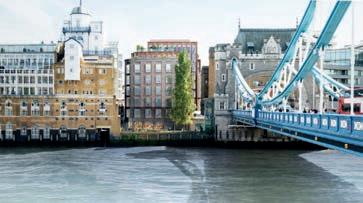
Walter Lilly celebrates its centenary
Contractor clocks up 100 years in business
Chartered building company
Walter Lilly has celebrated being in business for 100 years.
The firm started in April 1924 as a family business founded by tradesman, Walter Gent Lilly, who capitalised on his good fortune after winning the freehold of a London builder’s yard in a game of cards.
The company was acquired by YJ Lovell Group (later Renew Holdings) in 1955 and grew its portfolio to include some of London’s most prestigious buildings, including Café Royal, Southwark Cathedral, the Palace of Westminster, 1 Cornwall Terrace – Britain’s most expensive terraced property at the time – and 100 Park Lane, one of the few surviving aristocratic townhouses in London.
The project team working on TBC.London, a new landmark Thamesside net zero office space being built by Willmott Dixon, raised funds for the charity Mind during Mental Health Awareness Week by walking a half marathon.
The challenge, which fitted with the theme for this year of ‘Movement’, was organised by Matthew Adams MCIOB from Willmott Dixon Construction alongside Sarah Trahair-Williams of FORE Partnership (client and developer of TBC.London).
More recently, it delivered its largest project to date, the £84m Laboratory of Medical Sciences for the Medical Research Council.
As the focus shifts towards the UK government’s 2025 net zero target, Walter Lilly is working alongside its clients to provide sustainable project delivery. Examples include the reservicing of a number of Grade-I London palaces to assist in achieving carbon neutral estates including a BREEAM Excellent rating.
Walter Lilly managing director Chris Butler said: “This anniversary represents not only a century of hard work, determination and continuous improvement, but also the immense potential that awaits us as we look to the future.” ●
100.walterlilly.co.uk
The route started at FORE Partnership’s New Bond Street office via Tower Bridge to the finish line on the TBC.London site.
Adams said: “This charity is close to several of our team members’ hearts, with their family greatly assisted by them in the past, and therefore we were very happy to come together as a unit to support this charity.
“The walk not only allowed us to appreciate nature but appreciate the essence of time and that taking time out in the day doing something for ourselves is very important for our own health, physically and mentally.” ●
54 | CONSTRUCTION MANAGEMENT JULY/AUGUST 2024 n CIOB Community constructionmanagement.co.uk
The MRC Laboratory of Medical Sciences facility
Walter Gent Lilly (third from right) founded the firm
The half marathon ended at the new TBC.London building by the Thames
Morgan
Sindall
helps homeless in outreach initiative
Supply chain donations made charity initiative a success
Morgan Sindall and its supply chain partners helped the homeless during Mental Health Awareness Week.
The main contractor invited homeless people to various sites where it provided meals, toiletries, sleeping bags and haircuts, thanks to donations from a wide number of supply chain partners.
Site teams came together on the day to assist at different locations, partnering with local businesses to support those close to site projects that needed help.
Morgan Sindall reported high levels of engagement from those in need, saying it highlights the need to “do more to support when building communities in local areas as well as volunteer time when we all can”.
Morgan Sindall Construction site manager Gurdeep Singh Jandoo MCIOB volunteered at an event at the Bobby Moore sports centre in Newham, east London.
He said: “It was a very heartwarming and wholesome afternoon, which was well received by the many people we were fortunate enough to serve. Their gratitude for the hot meal and care package was a reminder of why it is so important to share with others and help the less fortunate.
He added that it was “a genuine reminder of how privileged and lucky we are to have a home to go to at the end of the day, food to fill our stomachs and to have friends and family there for us”. ●
It was a very heartwarming and wholesome afternoon, which was well received by the many people we were fortunate enough to serve Gurdeep Singh Jandoo MCIOB, Morgan Sindall Construction
n NEWS IN BRIEF
CIOB Belfast annual dinner proves a success Over 200 people attended the CIOB annual dinner event at the Hilton Hotel in Belfast in May. Master of ceremonies was BBC Northern Ireland news journalist Mark Simpson. Speakers were Jonathan Payne, chair of the CIOB Northern Ireland Hub committee, and Caroline Gumble, CEO of CIOB. Popular comedian Paddy McDonnell provided the post-dinner entertainment. Sponsors were Training LMS, Tughans, Hays, MJM Marine and Keystone Lintels. Over £2,300 was raised on the night for CIOB Assist.
Chartered members to be recognised at Scotland Awards CIOB in Scotland Awards Lunch 2024 will take place on 11 October at DoubleTree by Hilton Glasgow Central. The event will be hosted by Nicky Marr and guest speaker is Irish comedian Keith Farnan. All MCIOB and FCIOB members who have achieved their designation this year will be recognised as part of the event. Contact wmarshall@ciob.org.uk for a booking form.


From left: Julie Fitzsimmons, member services and events coordinator for CIOB Northern Ireland; Jonathan Payne, chair of the CIOB Northern Ireland Hub committee; Caroline Gumble, chief executive officer of CIOB; and Yvonne Conway, vice chair of CIOB Northern Ireland Hub committee
Cambridge Hub hears about retrofitting occupied housing
How to tackle retrofitting in homes that are already occupied was explained by leading experts at a Cambridge Hub event in May.
Geoff Parkinson, head of procurement at Fortem Solutions, discussed the challenges of retrofitting social housing.
He was followed by Steve Nesbitt from MTC, who provided commentary on the key concerns and opportunities of retrofitting when homes are occupied.
The event was held at Cambridge Regional College.
CIOB presents fundraising results to Lighthouse
Club
CIOB’s Maidstone Hub committee has presented the proceeds from the raffle held at its recent Construction Professionals’ Dinner to the Lighthouse Club, the charity dedicated to the wellbeing of construction workers and their families.
The sum of £2,431 was presented at a hub CPD event by hub chair Oma Megbele MCIOB and vice chair Adam Mitchell FCIOB to Lighthouse Club ambassador Shauna Greenaway. Greenaway expressed her thanks to everyone, explaining that the work of the charity is more relevant today than ever before, with a record number of enquiries.
CONSTRUCTION MANAGEMENT JULY/AUGUST 2024 | 55 CIOB Community n constructionmanagement.co.uk
Maidstone Hub’s Oma Megbele (left) and Adam Mitchell present Shauna Greenaway with the funds raised

Preserving heritage with Velux windows
Clients of chartered architect Spence and Dower were looking to create a forever home for their family in a large conservation area in Tynemouth, Tyne and Wear. Their semi-detached villa was built between 1900 and 1929 and it was essential for them to preserve and enhance the home’s character and appearance. However, while they had six big double bedrooms, there weren’t enough bathrooms and the living space felt cramped. The loft area consisted of one small rooflight in the landing and an internal window in the bathroom towards the landing.
Design iterations
The design process focused on addressing the client’s needs while respecting the property’s heritage.
Several key iterations were proposed by the architect for the loft area:
● using Velux roof windows to bring in additional light and to make the space feel more open and brighter;
● adding a further rooflight in the loft space above the shower room to give the loft platform two windows for stargazing in different directions; and
● introducing three linked rooflights between the exposed purlins as a solution to the dark top landing of the stairwell.
Loft bathroom space transformation
The top floor bathroom had no external windows, but it did have an internal one facing the indoor landing area. Therefore it was necessary to open the bathroom loft area to install a ventilation system.
After one Velux Heritage conservation roof window had been installed in the bathroom, the effect of daylight was immediately evident –it transformed the space
The clients were keen to follow the architect’s proposal. However, during construction, the Velux Heritage conservation roof window was launched. This sleek and subtle low-profile design played a significant role in their decision because it guaranteed to harmonise with the house’s style.
Stairwell illumination
After one Velux Heritage conservation roof window had been installed in the bathroom, the effect of daylight was immediately evident – it transformed the space. The client wanted the same effect at the top of the central staircase.
Two Velux Heritage conservation roof windows were installed between exposed purlins to brighten the dark top landing and extend into the adjacent shower room. This allowed daylight to flow through the house’s central staircase, as well as maintaining the natural ventilation flow.
Outcome
With the installation of two Velux Heritage conservation roof windows in the landing, the period property embraced the influx of daylight and the fresh ventilation flow through the central staircase of the house. Installing a large Velux Heritage conservation roof window – featuring a hand winder – in the bathroom made it possible to air the space and ventilate it thoroughly.
The alterations promised to create a versatile and inviting space for the family to enjoy for generations to come, while preserving the heritage of the building. ● For information, visit velux.co.uk/heritage
56 | CONSTRUCTION MANAGEMENT JULY/AUGUST 2024 n Partnership constructionmanagement.co.uk
In association with
New heritage roof windows provide key to modern living in a period property


Hundreds of the best jobs in construction. Recruitment news and insight. Employers seeking CIOB members. www.constructionmanagementjobs.co.uk CONSTRUCTION MANAGEMENT Brought to you by JOBS

Diary dates
Highlights of the CIOB Calendar for the coming month
Building mindfulness in a busy, fast-paced work life
9 July, 5.30-7.30pm, London Feeling the stress of working in construction, with its tight deadlines and highly pressured projects? You are not alone!
This talk is created for highly driven construction professionals to discover the power of mindfulness and how you can build it into your busy working week for a happier work/life balance.
This talk aims to help you to alleviate stress and anxiety, leaving you feeling energised and happier within yourself. Whether you’re new to mindfulness practices or already familiar with them, you can find out more



and be personally guided in a mindful visualisation.
Not only will you learn some quick and easy tips to use, be prepared to relax and unwind as we finish with a guided mindfulness meditation giving you some calm and relaxation in your busy working week.
Delivered by Chia Oh, a chartered marketer, an accredited meditation teacher, Reiki master teacher and hypnotherapist and former CIOB staff member. Register via www.ciob.org/events.
The Building Safety Act: Implications for clients, designers and contractors 10 July, 12-1pm, online Join Eddie Tuttle, CIOB director of policy, external affairs and research, and CIOB past president Paul Nash for this building regulations presentation followed by a Q&A.
Since the 2017 Grenfell Tower disaster, a complex new regime of building safety legislation has been introduced.
The Building Safety Act 2022, which came into force from 1 April 2023, introduced the most radical change to the English regulatory landscape for the built environment in a generation.
Switchboard: +44 (0)20 7490 5595
Editor: Will Mann
will.mann@atompublishing.co.uk
Deputy editor: Cristina Lago cristina.lago@atompublishing.co.uk
Production editor: Sarah Cutforth
Art editor: Heather Rugeley
Community editor: Nicky Roger nicky.roger@atompublishing.co.uk
Advertising manager: Dave Smith david.smith@atompublishing.co.uk
Key account manager: Tom Peardon
tom.peardon@atompublishing.co.uk
Credit control: Eva Rugeley eva@atompublishing.co.uk
Managing director: Stephen Quirke stephen@atompublishing.co.uk
The legislation is intended to improve the design, construction and management of higher-risk buildings. Needless to say, many of the changes have far-reaching consequences for construction clients.
Contact: dmoore@ciob.org.uk
Biodiversity Net Gain 16 July, 6-8pm, Thames Lido, Reading Landscape Institute presidentelect Carolin Göhler will highlight the importance of a well-designed landscape for delivering biodiversity net gain, including multiple benefits for health and wellbeing, climate and biodiversity. She will discuss: l the general background and concept of biodiversity net gain; l benefits for health and wellbeing, climate and biodiversity; l insights and tips for clients; and l the wider context and professional responsibilities.
This will be followed by a Q&A session.
Contact: ecatalano@ciob.org.uk
Factory of the Future –Tour of Innovaré, Coventry 18 July, 8.30-11.15am Join the team at Innovaré for a tour of its state-of-the-art facility in Coventry.
Circulation: Net average 30,842
Audit period: July 2022 to June 2023
Subscriptions: To subscribe or for enquiries, please contact: Subscription team: Tel: 01293 312160
Or go online at: https://constructionmanagement. imbmsubscriptions.com
Or write to us at the address below: Construction Management
Published for the Chartered Institute of Building by Atom Media Partners, 26-27 Bedford Square, London United Kingdom. WC1B 3HP construction-management@ atompublishing.co.uk
Innovaré is an offsite specialist delivering low-carbon structural and envelope solutions.
It is a market leader in delivering panelised offsite techniques to simplify the construction process and work in the education, health and residential sectors.
During this presentation and factory tour you will see how it combines sustainability, compliance and MMC.
Contact: sshort@ciob.org.uk
Site visit: MMC in action at Northminster Residential Project, Peterborough 31 July, 4.30-6pm Join CIOB’s Cambridge Hub for this site visit to Northminster Residential Project, Peterborough, which will demonstrate MMC in action.
Following on from our successful site visit last year, we are pleased to be visiting again to see the progress made.
This site tour will demonstrate the MMC and offsite techniques being used to deliver this significant mid-rise residential development in the heart of the city of Peterborough.
Contact: slaing@ciob.org.uk
For a full list of events and to register visit www.ciob.org/events.
Construction Management is published monthly by Atom Media Partners. The contents of this magazine are copyright. Reproduction in part or in full is forbidden without permission of the editor. The opinions expressed by writers of signed articles (even with pseudonyms) and letters appearing in the magazine are those of their respective authors, and neither CIOB, Atom Media Partners nor Construction Management is responsible for these opinions or statements. The editor will give careful consideration to material submitted – articles, photographs, drawings and so on – but does not undertake responsibility for damage or their safe return. Printed by Precision Colour Printing. All rights in the magazine, including copyright, content and design, are owned by CIOB and/or Atom Media Partners. ISSN 2755 8649
58 | CONSTRUCTION MANAGEMENT JULY/AUGUST 2024 n CIOB Community constructionmanagement.co.uk
JULY/AUGUST 2024 CONSTRUCTION MANAGEMENT ENVELOPE COMPETENCY GREEN ROOFS AND FIRE SAFETY HERITAGE IN CORNWALL constructionmanagement.co.uk GLOBAL PERSPECTIVE CIOB PRESIDENT MIKE KAGIOGLOU EXPLAINS THE UN SUSTAINABLE DEVELOPMENT GOALS

2 | CONSTRUCTION MANAGEMENT MARCH 2023 Construction’s new people development resource Expert opinions, career case studies, practical guides and events across a range of people development topics Women in Construction Mental Health Equality, Diversity & Inclusion Apprenticeships Social Value Wellbeing Learning & Training Employee Engagement HR Tech Maternity & Paternity Leadership Flexible Working Tomorrow’s Leaders www.ciobpeople.com








































 Caroline Gumble CIOB
Caroline Gumble CIOB








































 Luke Chamberlain Decipher
Luke Chamberlain Decipher




























